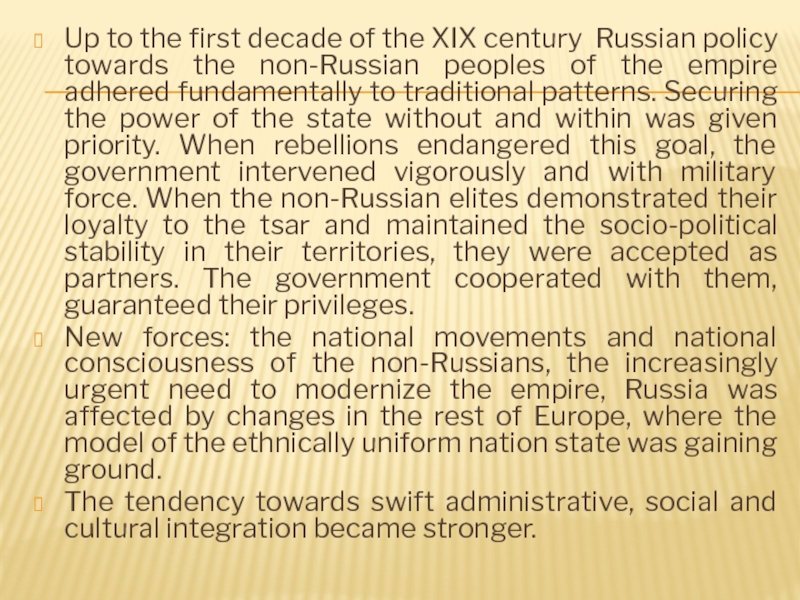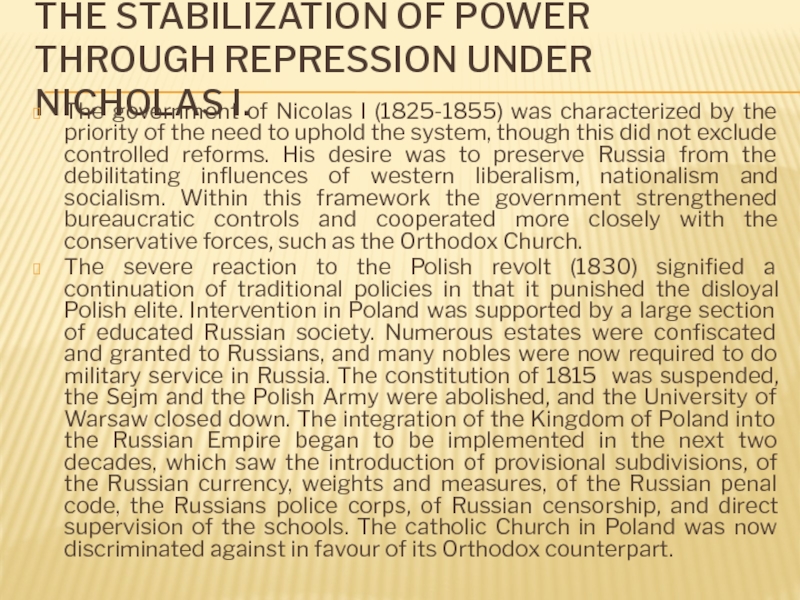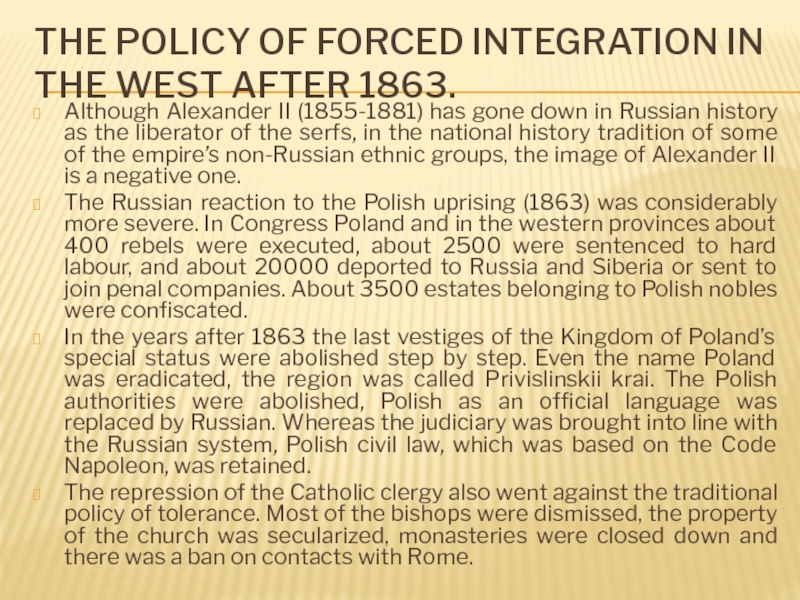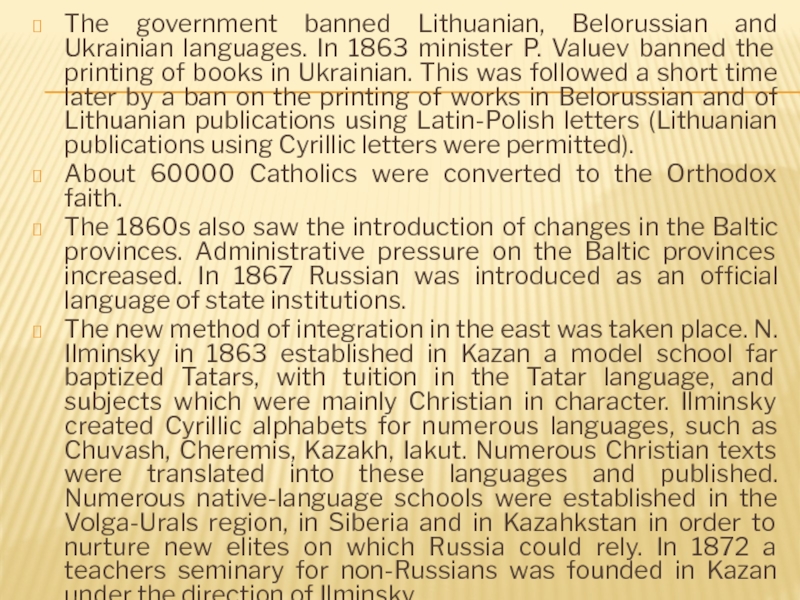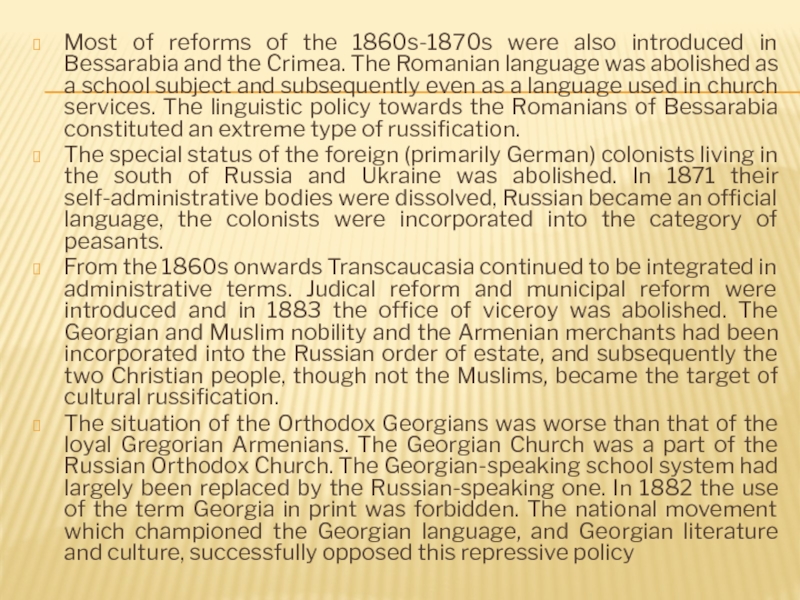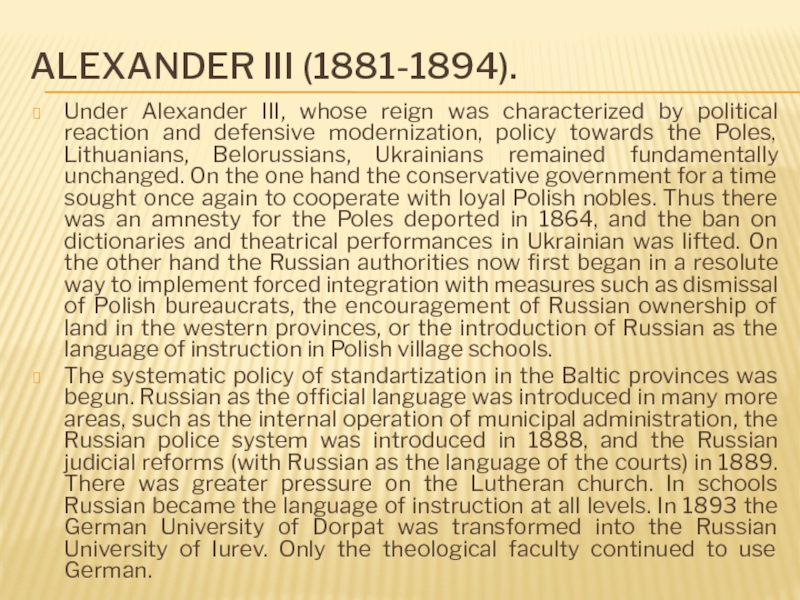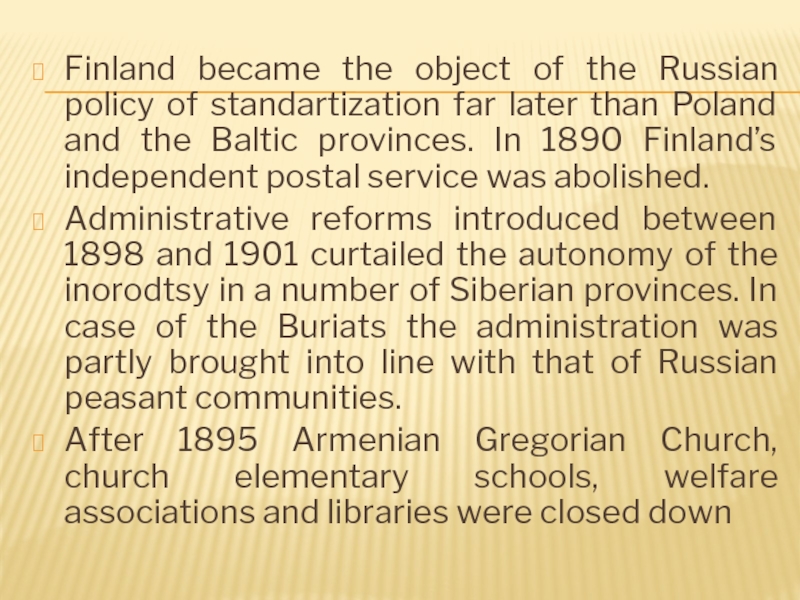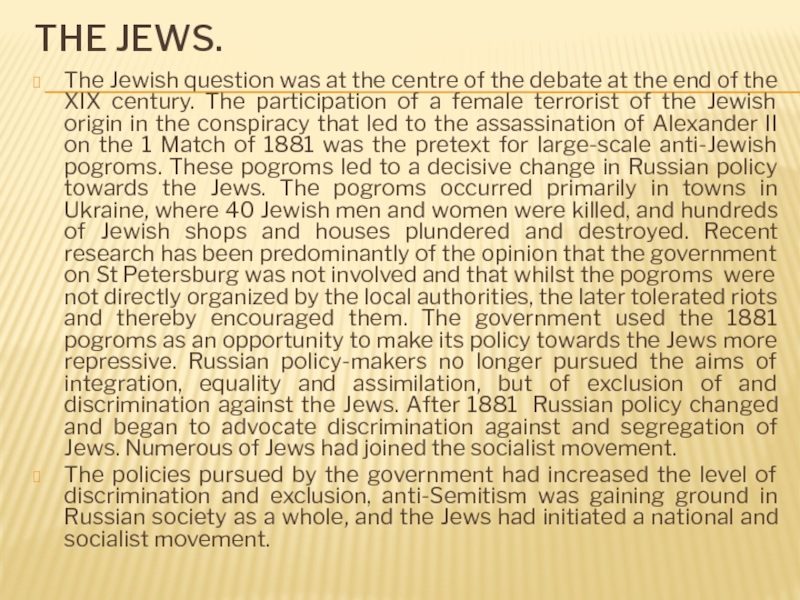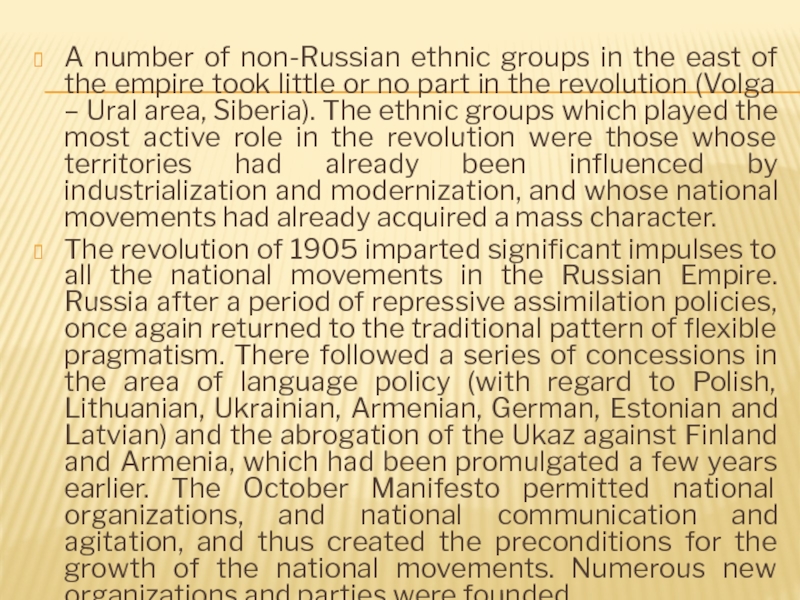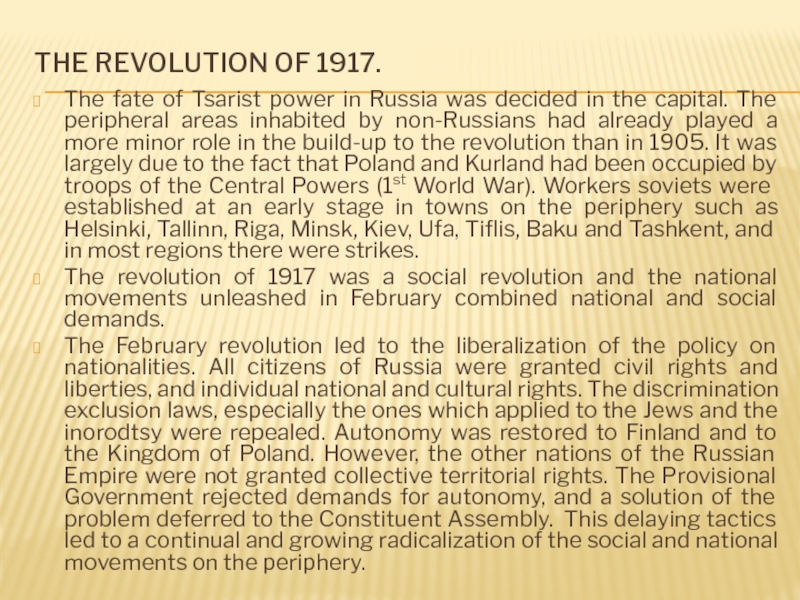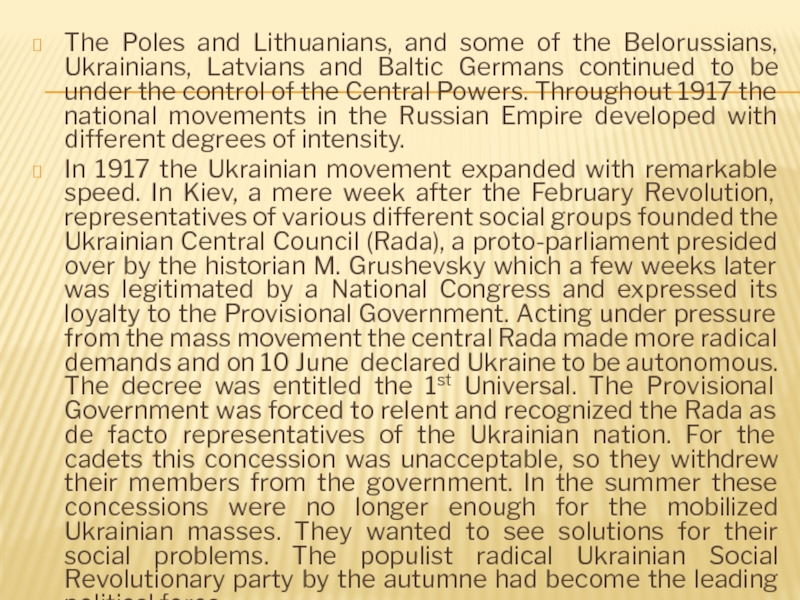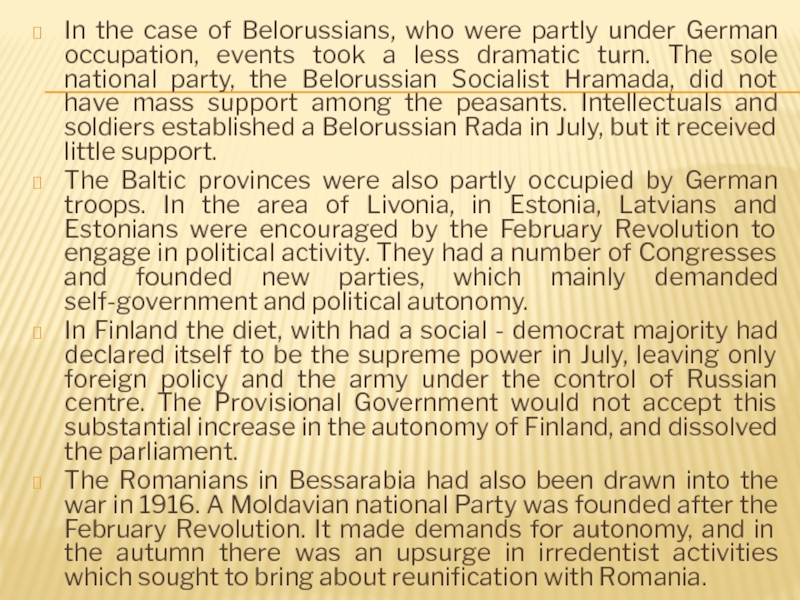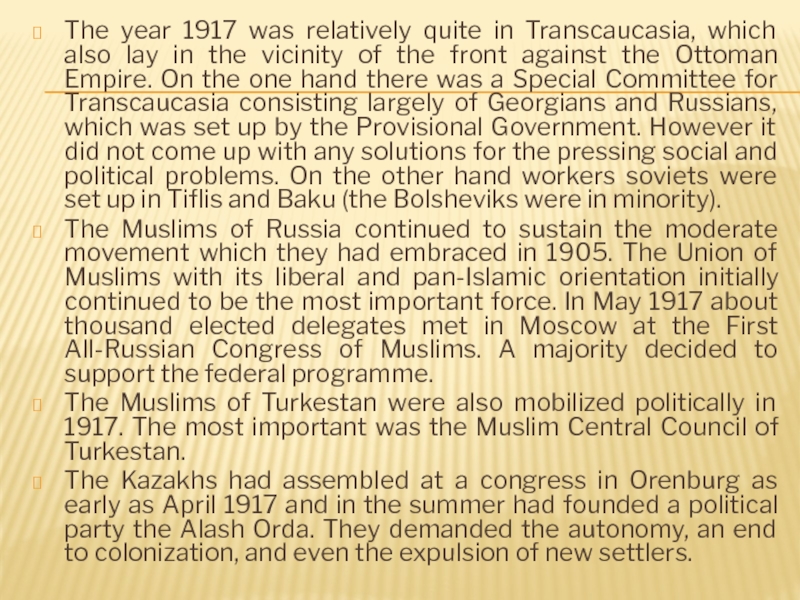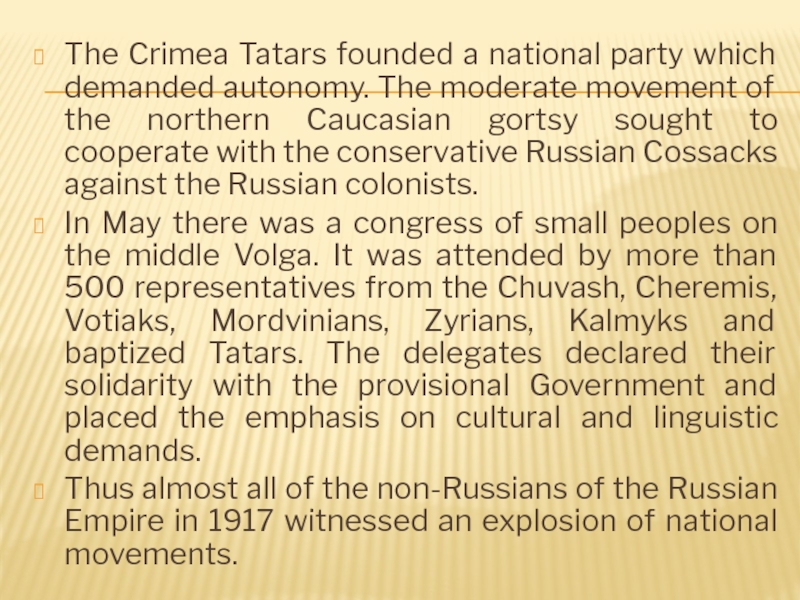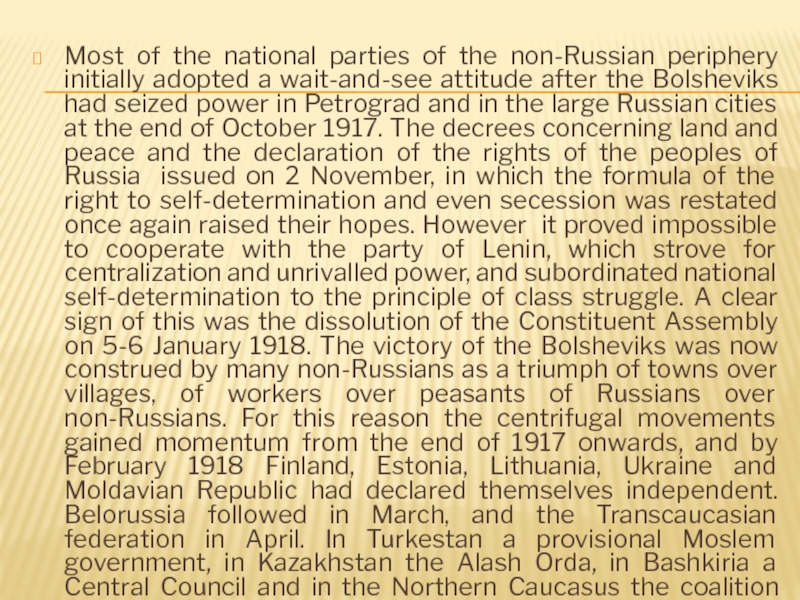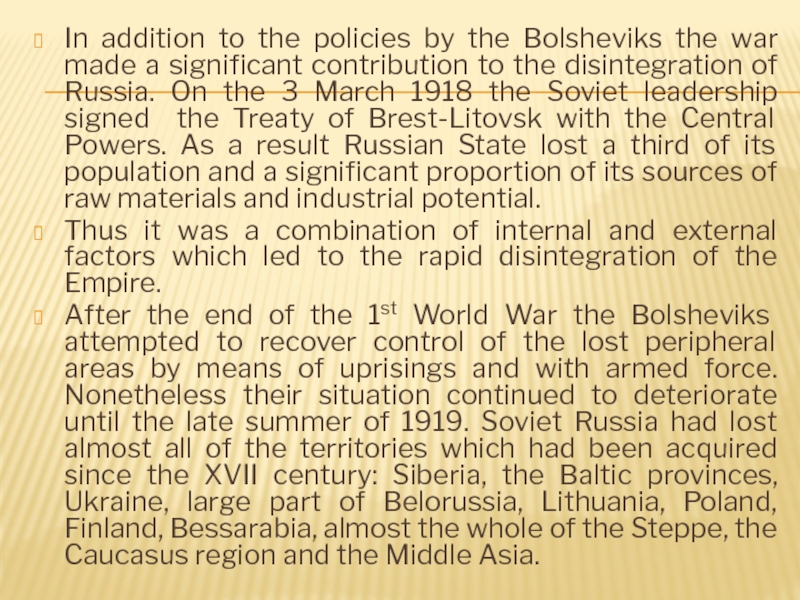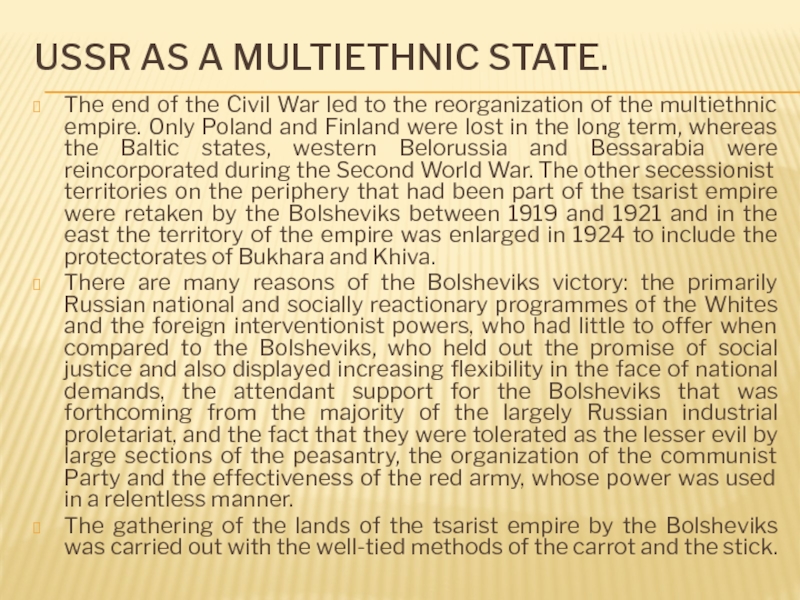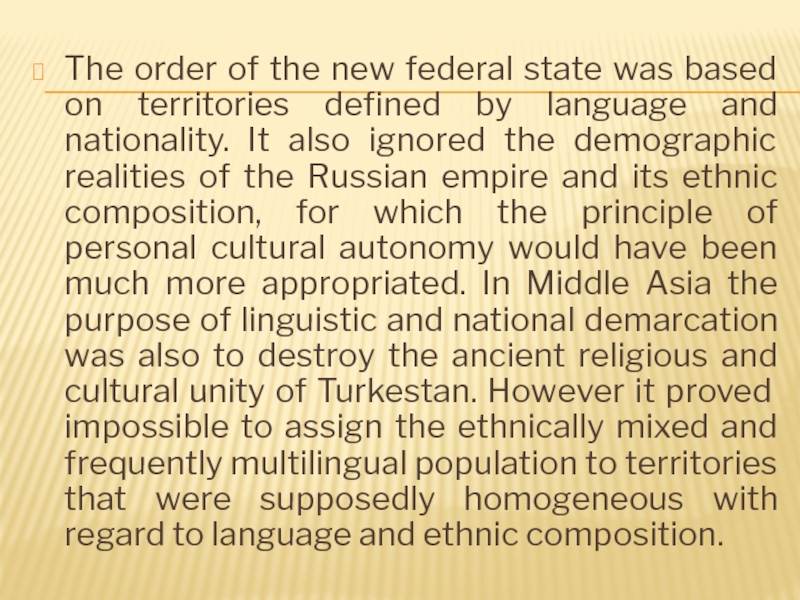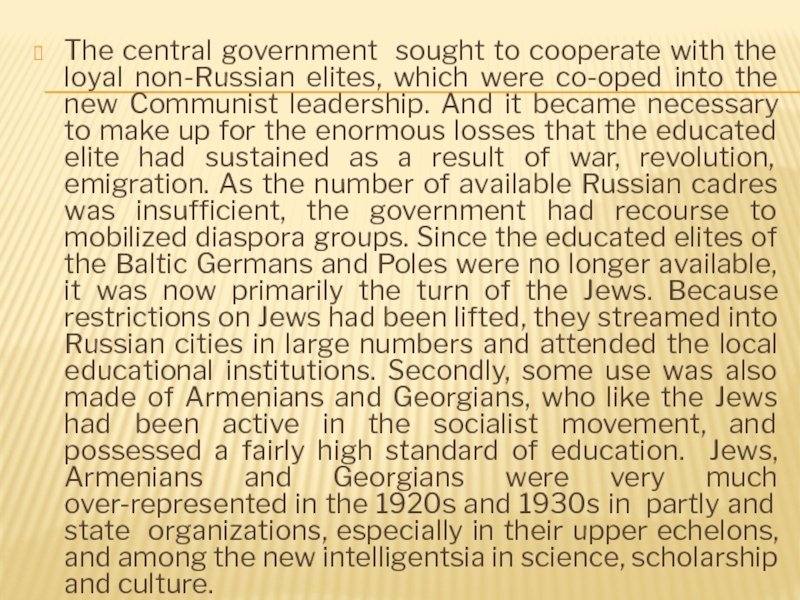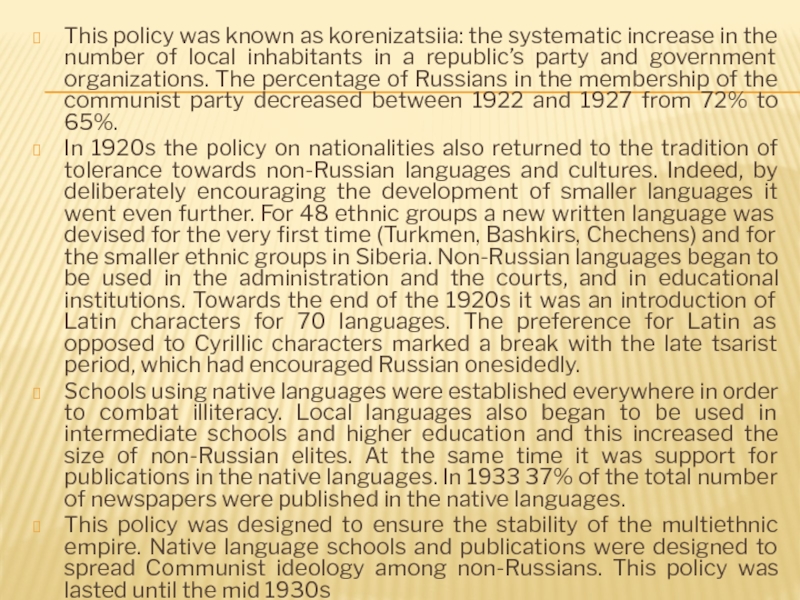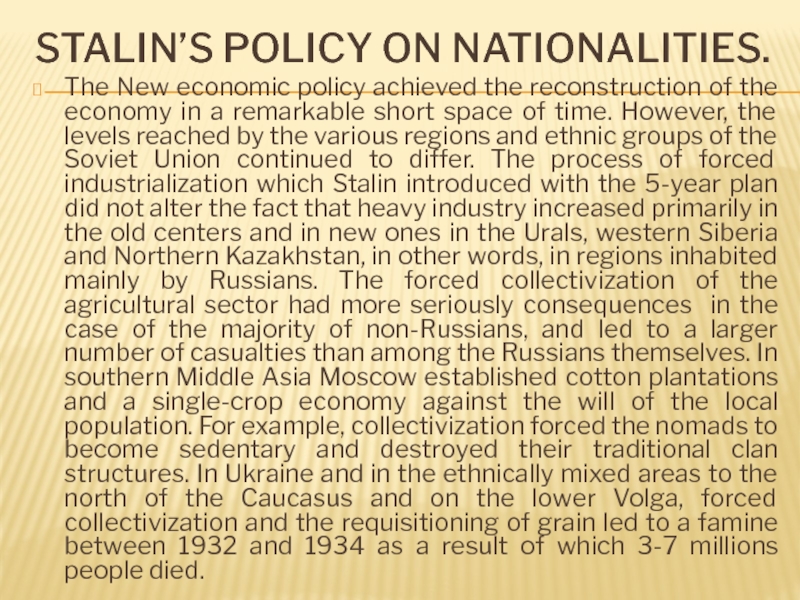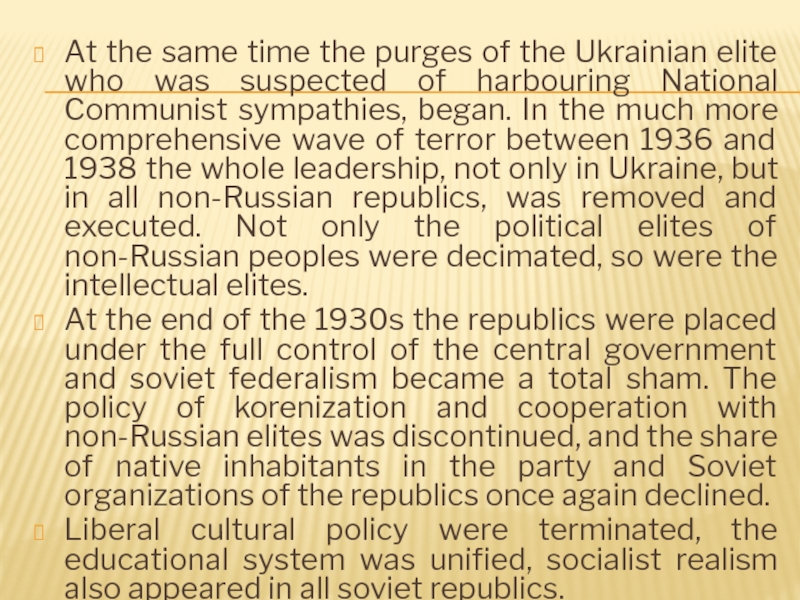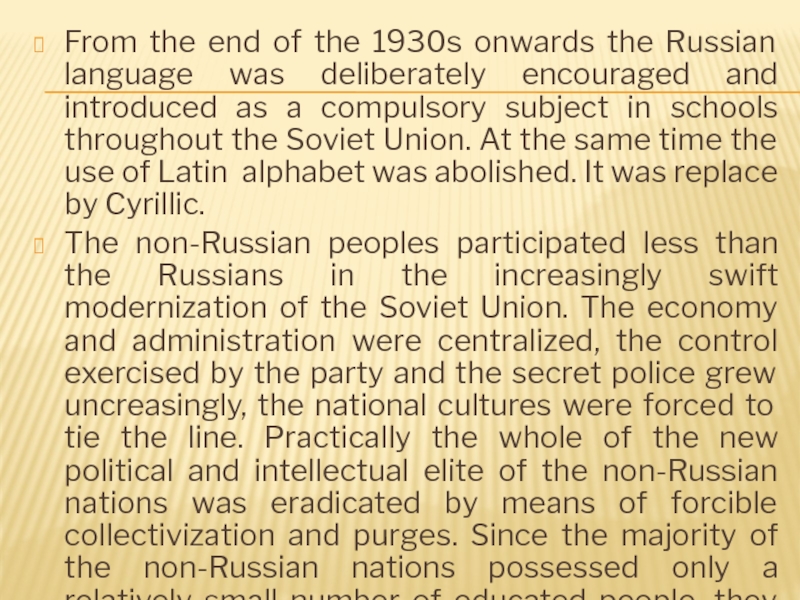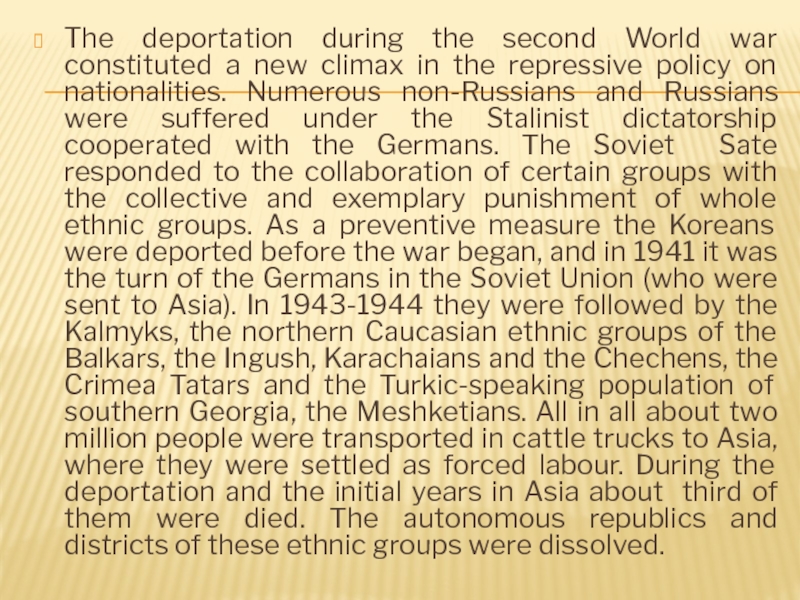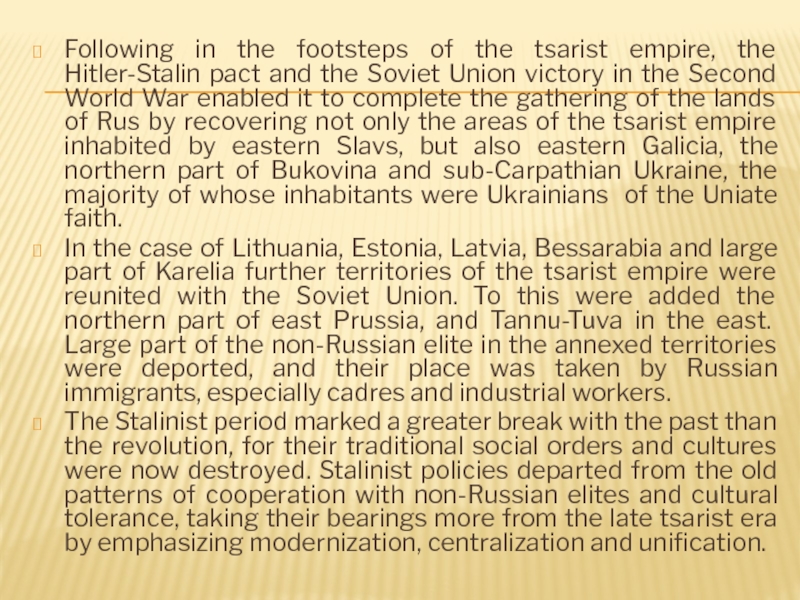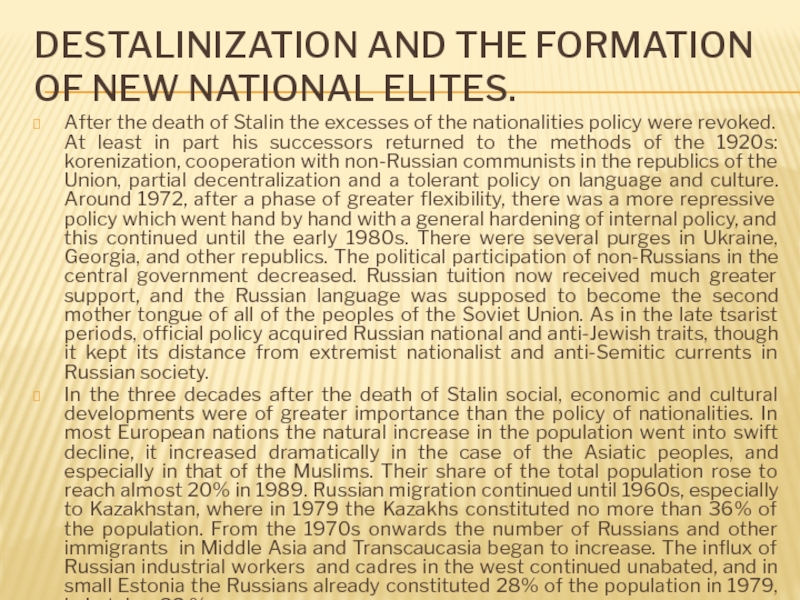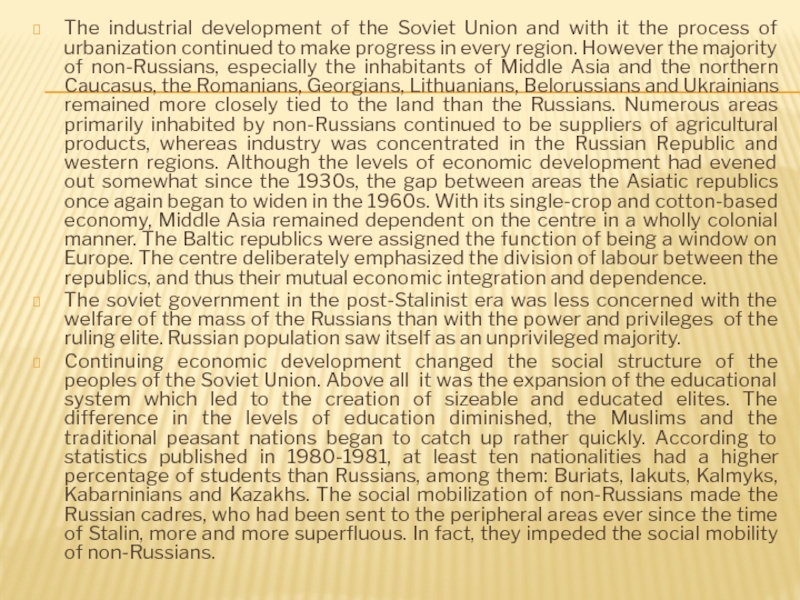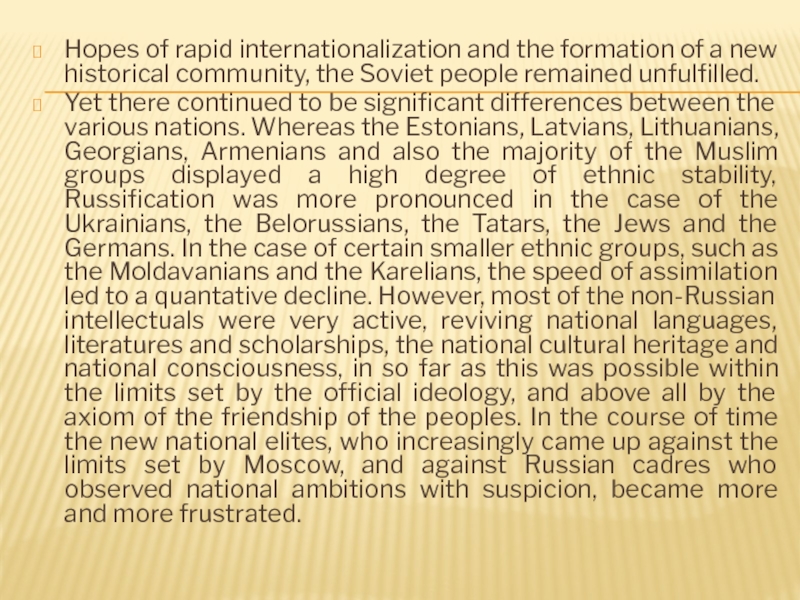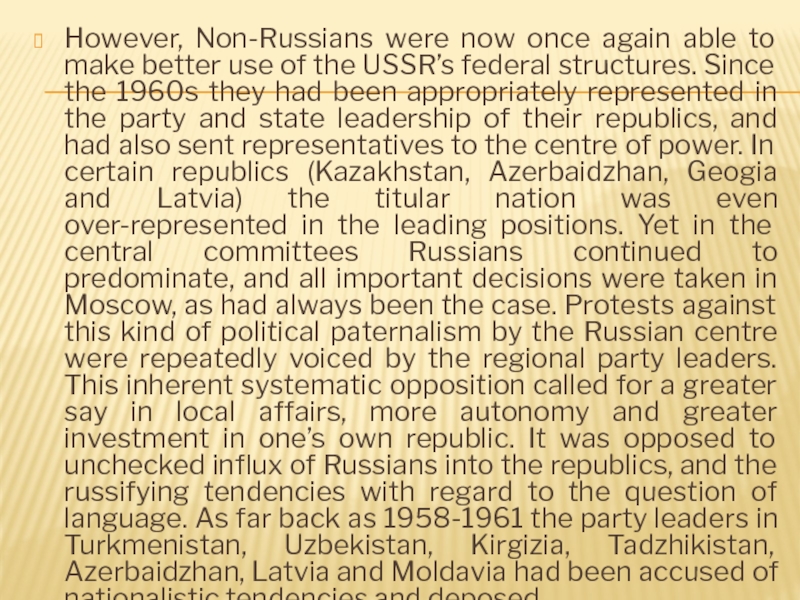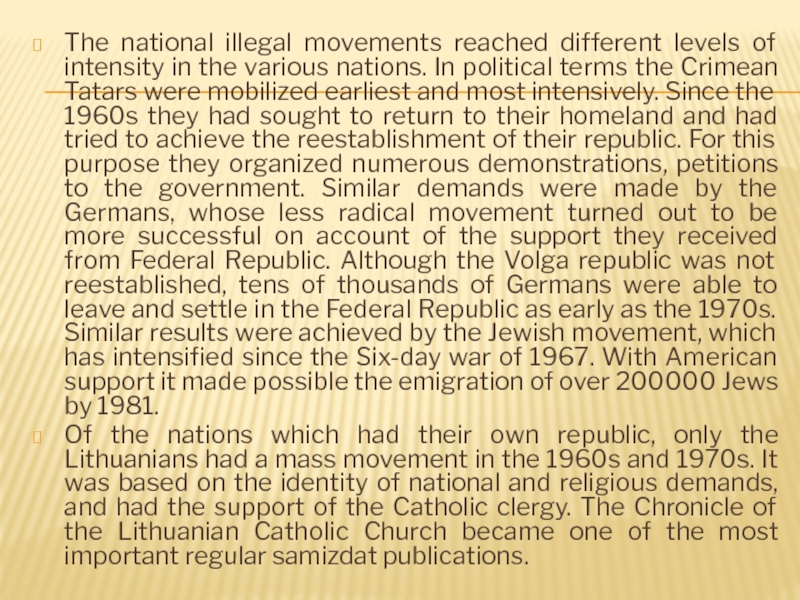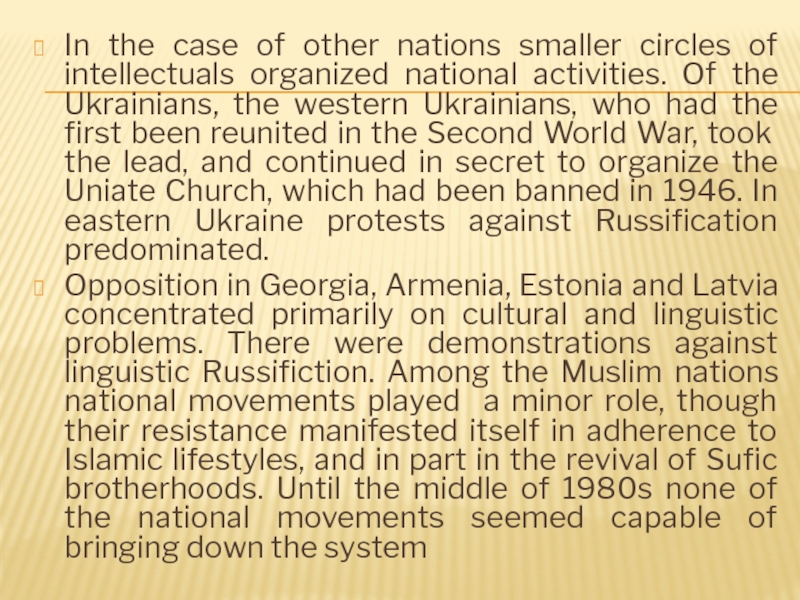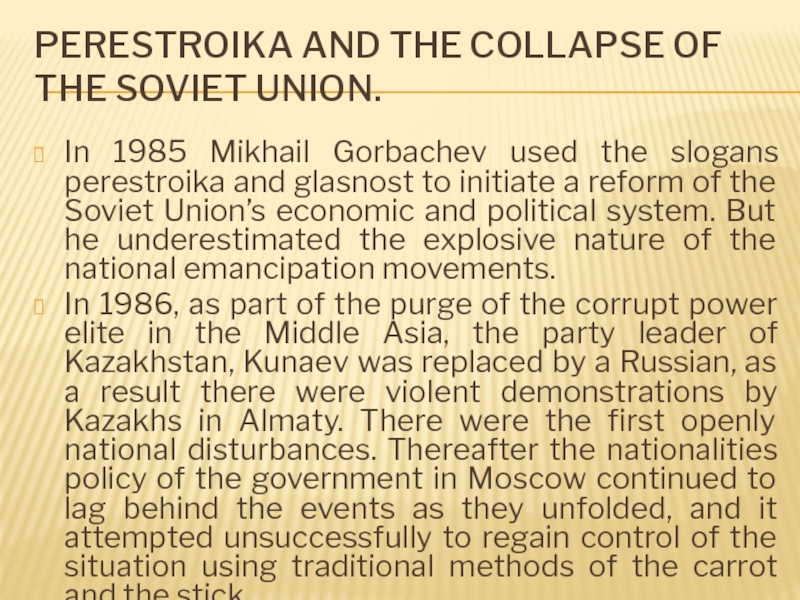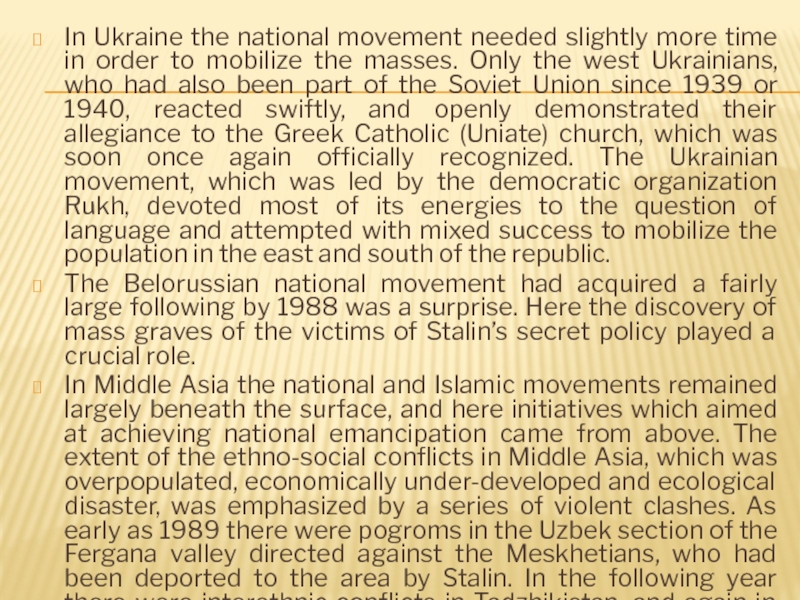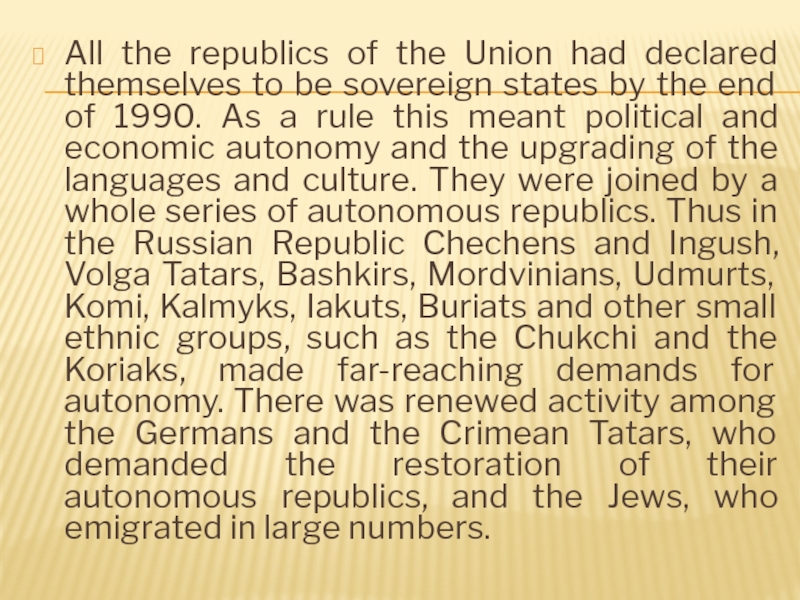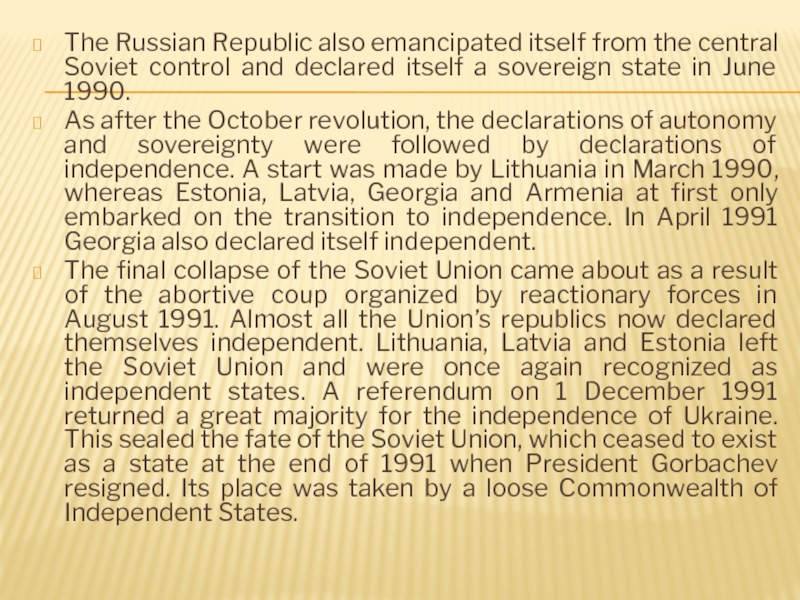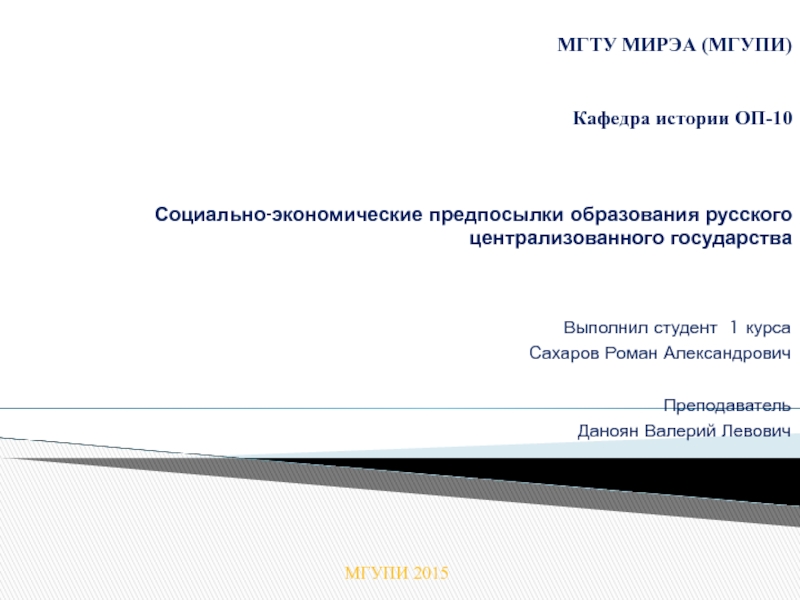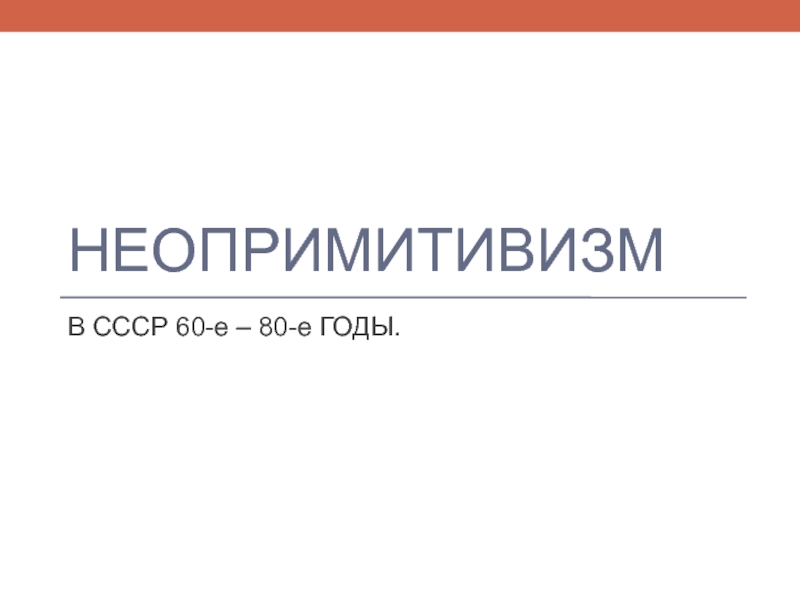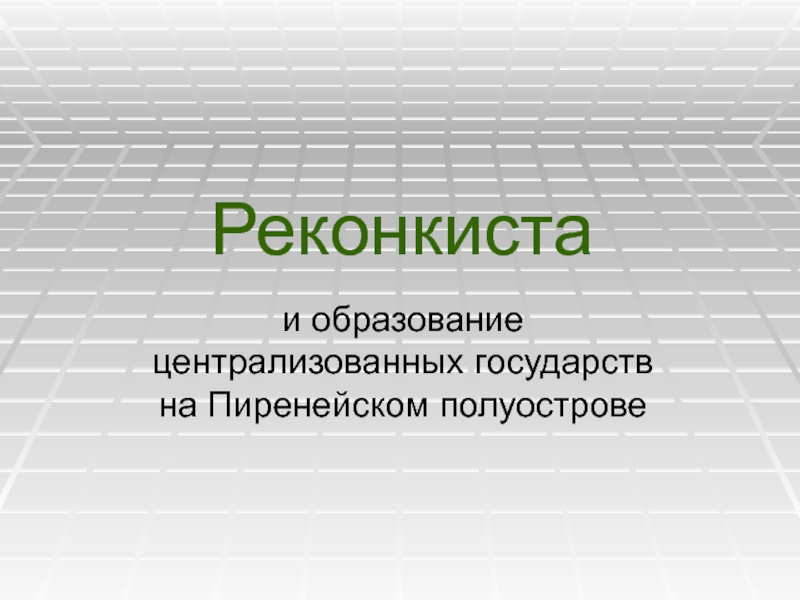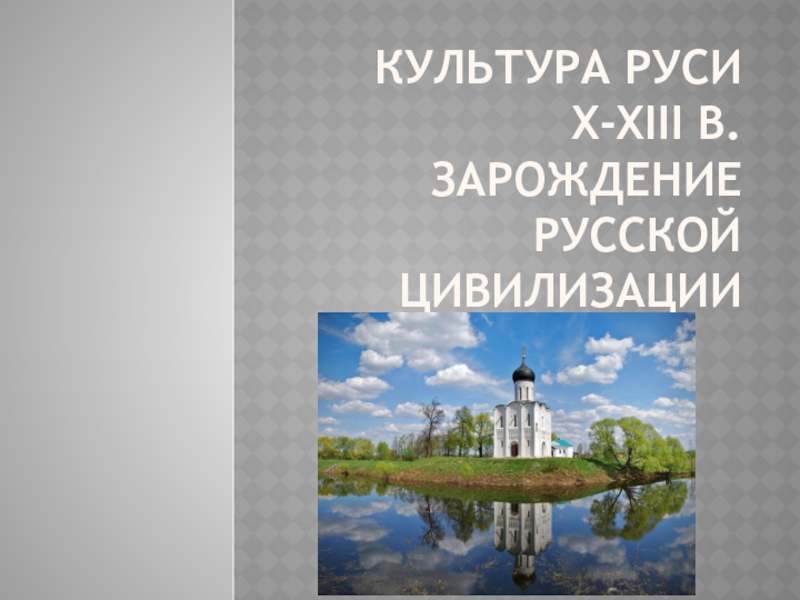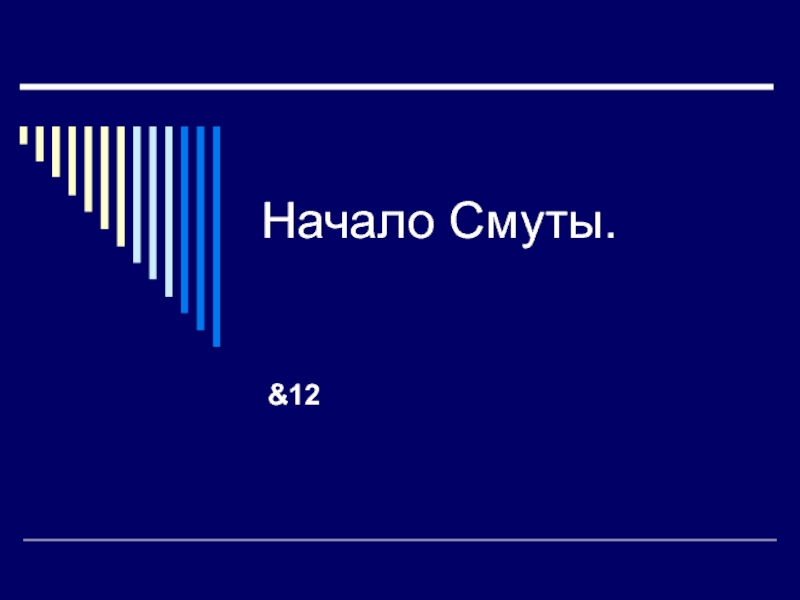- Главная
- Разное
- Дизайн
- Бизнес и предпринимательство
- Аналитика
- Образование
- Развлечения
- Красота и здоровье
- Финансы
- Государство
- Путешествия
- Спорт
- Недвижимость
- Армия
- Графика
- Культурология
- Еда и кулинария
- Лингвистика
- Английский язык
- Астрономия
- Алгебра
- Биология
- География
- Детские презентации
- Информатика
- История
- Литература
- Маркетинг
- Математика
- Медицина
- Менеджмент
- Музыка
- МХК
- Немецкий язык
- ОБЖ
- Обществознание
- Окружающий мир
- Педагогика
- Русский язык
- Технология
- Физика
- Философия
- Химия
- Шаблоны, картинки для презентаций
- Экология
- Экономика
- Юриспруденция
Post-soviet sphere (4-5) презентация
Содержание
- 1. Post-soviet sphere (4-5)
- 2. Up to the first decade of the
- 3. THE STABILIZATION OF POWER THROUGH REPRESSION UNDER
- 4. The Lithuanians, Belorussians and Ukrainians now gradually
- 5. THE POLICY OF FORCED INTEGRATION IN THE
- 6. The government banned Lithuanian, Belorussian and Ukrainian
- 7. Most of reforms of the 1860s-1870s were
- 8. ALEXANDER III (1881-1894). Under Alexander III, whose
- 9. Finland became the object of the Russian
- 10. THE JEWS. The Jewish question was at
- 11. THE NATIONALITIES QUESTION AND THE REVOLUTIONS. At
- 12. A number of non-Russian ethnic groups in
- 13. THE REVOLUTION OF 1917. The fate
- 14. The Poles and Lithuanians, and some of
- 15. In the case of Belorussians, who were
- 16. The year 1917 was relatively quite in
- 17. The Crimea Tatars founded a national party
- 18. Most of the national parties of the
- 19. In addition to the policies by the
- 20. USSR AS A MULTIETHNIC STATE. The end
- 21. As early as 1918 Lenin returned to
- 22. The order of the new federal state
- 23. THE GOLDEN TWENTIES. In the early years
- 24. The central government sought to cooperate with
- 25. This policy was known as korenizatsiia: the
- 26. STALIN’S POLICY ON NATIONALITIES. The New economic
- 27. At the same time the purges of
- 28. From the end of the 1930s onwards
- 29. The deportation during the second World war
- 30. Following in the footsteps of the tsarist
- 31. DESTALINIZATION AND THE FORMATION OF NEW NATIONAL
- 32. The industrial development of the Soviet Union
- 33. Hopes of rapid internationalization and the formation
- 34. However, Non-Russians were now once again able
- 35. The national illegal movements reached different levels
- 36. In the case of other nations smaller
- 37. PERESTROIKA AND THE COLLAPSE OF THE SOVIET
- 38. The 1988 witnessed an explosion of national
- 39. In the course of 1988 Estonians, Latvians
- 40. In Ukraine the national movement needed slightly
- 41. All the republics of the Union had
- 42. The Russian Republic also emancipated itself from
Слайд 2Up to the first decade of the XIX century Russian policy
towards the non-Russian peoples of the empire adhered fundamentally to traditional patterns. Securing the power of the state without and within was given priority. When rebellions endangered this goal, the government intervened vigorously and with military force. When the non-Russian elites demonstrated their loyalty to the tsar and maintained the socio-political stability in their territories, they were accepted as partners. The government cooperated with them, guaranteed their privileges.
New forces: the national movements and national consciousness of the non-Russians, the increasingly urgent need to modernize the empire, Russia was affected by changes in the rest of Europe, where the model of the ethnically uniform nation state was gaining ground.
The tendency towards swift administrative, social and cultural integration became stronger.
New forces: the national movements and national consciousness of the non-Russians, the increasingly urgent need to modernize the empire, Russia was affected by changes in the rest of Europe, where the model of the ethnically uniform nation state was gaining ground.
The tendency towards swift administrative, social and cultural integration became stronger.
Слайд 3THE STABILIZATION OF POWER THROUGH REPRESSION UNDER NICHOLAS I.
The government of
Nicolas I (1825-1855) was characterized by the priority of the need to uphold the system, though this did not exclude controlled reforms. His desire was to preserve Russia from the debilitating influences of western liberalism, nationalism and socialism. Within this framework the government strengthened bureaucratic controls and cooperated more closely with the conservative forces, such as the Orthodox Church.
The severe reaction to the Polish revolt (1830) signified a continuation of traditional policies in that it punished the disloyal Polish elite. Intervention in Poland was supported by a large section of educated Russian society. Numerous estates were confiscated and granted to Russians, and many nobles were now required to do military service in Russia. The constitution of 1815 was suspended, the Sejm and the Polish Army were abolished, and the University of Warsaw closed down. The integration of the Kingdom of Poland into the Russian Empire began to be implemented in the next two decades, which saw the introduction of provisional subdivisions, of the Russian currency, weights and measures, of the Russian penal code, the Russians police corps, of Russian censorship, and direct supervision of the schools. The catholic Church in Poland was now discriminated against in favour of its Orthodox counterpart.
The severe reaction to the Polish revolt (1830) signified a continuation of traditional policies in that it punished the disloyal Polish elite. Intervention in Poland was supported by a large section of educated Russian society. Numerous estates were confiscated and granted to Russians, and many nobles were now required to do military service in Russia. The constitution of 1815 was suspended, the Sejm and the Polish Army were abolished, and the University of Warsaw closed down. The integration of the Kingdom of Poland into the Russian Empire began to be implemented in the next two decades, which saw the introduction of provisional subdivisions, of the Russian currency, weights and measures, of the Russian penal code, the Russians police corps, of Russian censorship, and direct supervision of the schools. The catholic Church in Poland was now discriminated against in favour of its Orthodox counterpart.
Слайд 4The Lithuanians, Belorussians and Ukrainians now gradually came to the notice
of the Russian Government, and there were attempts to contain the influence of the Catholic church and Polish culture on the peasant peoples. This aim was designed to promote the use of Russian instead of Polish, and by the final suppression of the Uniate church in the western provinces in 1839.
The Baltic provinces it encouraged attempts by the newly founded Orthodox bichopric of Riga to convert the Latvians and Estonians. The predominant position of German elite was preserved, and codification of provincial law completed in 1845, which confirmed their traditional privileges.
The same was true of Finland, whose internal autonomy was not changed. It was also true of the Armenians.
In the reign of Nicolas I the church and the Orthodox faith once again became important pillars of conservative state policy. The effect of this was felt in more severe policies towards the Jews, and in a revival of missionary activity.
In 1828 the autonomy of Bessarabia was substantially curtailed, and subsequently the Romanian language was banished from the administration and the schools.
A similar policy of assimilation was also pursued in the case of the Georgians.
Top priority continued to be accorded to social and political stability and to cooperation with loyal non-Russian elites.
The Baltic provinces it encouraged attempts by the newly founded Orthodox bichopric of Riga to convert the Latvians and Estonians. The predominant position of German elite was preserved, and codification of provincial law completed in 1845, which confirmed their traditional privileges.
The same was true of Finland, whose internal autonomy was not changed. It was also true of the Armenians.
In the reign of Nicolas I the church and the Orthodox faith once again became important pillars of conservative state policy. The effect of this was felt in more severe policies towards the Jews, and in a revival of missionary activity.
In 1828 the autonomy of Bessarabia was substantially curtailed, and subsequently the Romanian language was banished from the administration and the schools.
A similar policy of assimilation was also pursued in the case of the Georgians.
Top priority continued to be accorded to social and political stability and to cooperation with loyal non-Russian elites.
Слайд 5THE POLICY OF FORCED INTEGRATION IN THE WEST AFTER 1863.
Although Alexander
II (1855-1881) has gone down in Russian history as the liberator of the serfs, in the national history tradition of some of the empire’s non-Russian ethnic groups, the image of Alexander II is a negative one.
The Russian reaction to the Polish uprising (1863) was considerably more severe. In Congress Poland and in the western provinces about 400 rebels were executed, about 2500 were sentenced to hard labour, and about 20000 deported to Russia and Siberia or sent to join penal companies. About 3500 estates belonging to Polish nobles were confiscated.
In the years after 1863 the last vestiges of the Kingdom of Poland’s special status were abolished step by step. Even the name Poland was eradicated, the region was called Privislinskii krai. The Polish authorities were abolished, Polish as an official language was replaced by Russian. Whereas the judiciary was brought into line with the Russian system, Polish civil law, which was based on the Code Napoleon, was retained.
The repression of the Catholic clergy also went against the traditional policy of tolerance. Most of the bishops were dismissed, the property of the church was secularized, monasteries were closed down and there was a ban on contacts with Rome.
The Russian reaction to the Polish uprising (1863) was considerably more severe. In Congress Poland and in the western provinces about 400 rebels were executed, about 2500 were sentenced to hard labour, and about 20000 deported to Russia and Siberia or sent to join penal companies. About 3500 estates belonging to Polish nobles were confiscated.
In the years after 1863 the last vestiges of the Kingdom of Poland’s special status were abolished step by step. Even the name Poland was eradicated, the region was called Privislinskii krai. The Polish authorities were abolished, Polish as an official language was replaced by Russian. Whereas the judiciary was brought into line with the Russian system, Polish civil law, which was based on the Code Napoleon, was retained.
The repression of the Catholic clergy also went against the traditional policy of tolerance. Most of the bishops were dismissed, the property of the church was secularized, monasteries were closed down and there was a ban on contacts with Rome.
Слайд 6The government banned Lithuanian, Belorussian and Ukrainian languages. In 1863 minister
P. Valuev banned the printing of books in Ukrainian. This was followed a short time later by a ban on the printing of works in Belorussian and of Lithuanian publications using Latin-Polish letters (Lithuanian publications using Cyrillic letters were permitted).
About 60000 Catholics were converted to the Orthodox faith.
The 1860s also saw the introduction of changes in the Baltic provinces. Administrative pressure on the Baltic provinces increased. In 1867 Russian was introduced as an official language of state institutions.
The new method of integration in the east was taken place. N. Ilminsky in 1863 established in Kazan a model school far baptized Tatars, with tuition in the Tatar language, and subjects which were mainly Christian in character. Ilminsky created Cyrillic alphabets for numerous languages, such as Chuvash, Cheremis, Kazakh, Iakut. Numerous Christian texts were translated into these languages and published. Numerous native-language schools were established in the Volga-Urals region, in Siberia and in Kazahkstan in order to nurture new elites on which Russia could rely. In 1872 a teachers seminary for non-Russians was founded in Kazan under the direction of Ilminsky.
About 60000 Catholics were converted to the Orthodox faith.
The 1860s also saw the introduction of changes in the Baltic provinces. Administrative pressure on the Baltic provinces increased. In 1867 Russian was introduced as an official language of state institutions.
The new method of integration in the east was taken place. N. Ilminsky in 1863 established in Kazan a model school far baptized Tatars, with tuition in the Tatar language, and subjects which were mainly Christian in character. Ilminsky created Cyrillic alphabets for numerous languages, such as Chuvash, Cheremis, Kazakh, Iakut. Numerous Christian texts were translated into these languages and published. Numerous native-language schools were established in the Volga-Urals region, in Siberia and in Kazahkstan in order to nurture new elites on which Russia could rely. In 1872 a teachers seminary for non-Russians was founded in Kazan under the direction of Ilminsky.
Слайд 7Most of reforms of the 1860s-1870s were also introduced in Bessarabia
and the Crimea. The Romanian language was abolished as a school subject and subsequently even as a language used in church services. The linguistic policy towards the Romanians of Bessarabia constituted an extreme type of russification.
The special status of the foreign (primarily German) colonists living in the south of Russia and Ukraine was abolished. In 1871 their self-administrative bodies were dissolved, Russian became an official language, the colonists were incorporated into the category of peasants.
From the 1860s onwards Transcaucasia continued to be integrated in administrative terms. Judical reform and municipal reform were introduced and in 1883 the office of viceroy was abolished. The Georgian and Muslim nobility and the Armenian merchants had been incorporated into the Russian order of estate, and subsequently the two Christian people, though not the Muslims, became the target of cultural russification.
The situation of the Orthodox Georgians was worse than that of the loyal Gregorian Armenians. The Georgian Church was a part of the Russian Orthodox Church. The Georgian-speaking school system had largely been replaced by the Russian-speaking one. In 1882 the use of the term Georgia in print was forbidden. The national movement which championed the Georgian language, and Georgian literature and culture, successfully opposed this repressive policy
The special status of the foreign (primarily German) colonists living in the south of Russia and Ukraine was abolished. In 1871 their self-administrative bodies were dissolved, Russian became an official language, the colonists were incorporated into the category of peasants.
From the 1860s onwards Transcaucasia continued to be integrated in administrative terms. Judical reform and municipal reform were introduced and in 1883 the office of viceroy was abolished. The Georgian and Muslim nobility and the Armenian merchants had been incorporated into the Russian order of estate, and subsequently the two Christian people, though not the Muslims, became the target of cultural russification.
The situation of the Orthodox Georgians was worse than that of the loyal Gregorian Armenians. The Georgian Church was a part of the Russian Orthodox Church. The Georgian-speaking school system had largely been replaced by the Russian-speaking one. In 1882 the use of the term Georgia in print was forbidden. The national movement which championed the Georgian language, and Georgian literature and culture, successfully opposed this repressive policy
Слайд 8ALEXANDER III (1881-1894).
Under Alexander III, whose reign was characterized by political
reaction and defensive modernization, policy towards the Poles, Lithuanians, Belorussians, Ukrainians remained fundamentally unchanged. On the one hand the conservative government for a time sought once again to cooperate with loyal Polish nobles. Thus there was an amnesty for the Poles deported in 1864, and the ban on dictionaries and theatrical performances in Ukrainian was lifted. On the other hand the Russian authorities now first began in a resolute way to implement forced integration with measures such as dismissal of Polish bureaucrats, the encouragement of Russian ownership of land in the western provinces, or the introduction of Russian as the language of instruction in Polish village schools.
The systematic policy of standartization in the Baltic provinces was begun. Russian as the official language was introduced in many more areas, such as the internal operation of municipal administration, the Russian police system was introduced in 1888, and the Russian judicial reforms (with Russian as the language of the courts) in 1889. There was greater pressure on the Lutheran church. In schools Russian became the language of instruction at all levels. In 1893 the German University of Dorpat was transformed into the Russian University of Iurev. Only the theological faculty continued to use German.
The systematic policy of standartization in the Baltic provinces was begun. Russian as the official language was introduced in many more areas, such as the internal operation of municipal administration, the Russian police system was introduced in 1888, and the Russian judicial reforms (with Russian as the language of the courts) in 1889. There was greater pressure on the Lutheran church. In schools Russian became the language of instruction at all levels. In 1893 the German University of Dorpat was transformed into the Russian University of Iurev. Only the theological faculty continued to use German.
Слайд 9Finland became the object of the Russian policy of standartization far
later than Poland and the Baltic provinces. In 1890 Finland’s independent postal service was abolished.
Administrative reforms introduced between 1898 and 1901 curtailed the autonomy of the inorodtsy in a number of Siberian provinces. In case of the Buriats the administration was partly brought into line with that of Russian peasant communities.
After 1895 Armenian Gregorian Church, church elementary schools, welfare associations and libraries were closed down
Administrative reforms introduced between 1898 and 1901 curtailed the autonomy of the inorodtsy in a number of Siberian provinces. In case of the Buriats the administration was partly brought into line with that of Russian peasant communities.
After 1895 Armenian Gregorian Church, church elementary schools, welfare associations and libraries were closed down
Слайд 10THE JEWS.
The Jewish question was at the centre of the debate
at the end of the XIX century. The participation of a female terrorist of the Jewish origin in the conspiracy that led to the assassination of Alexander II on the 1 Match of 1881 was the pretext for large-scale anti-Jewish pogroms. These pogroms led to a decisive change in Russian policy towards the Jews. The pogroms occurred primarily in towns in Ukraine, where 40 Jewish men and women were killed, and hundreds of Jewish shops and houses plundered and destroyed. Recent research has been predominantly of the opinion that the government on St Petersburg was not involved and that whilst the pogroms were not directly organized by the local authorities, the later tolerated riots and thereby encouraged them. The government used the 1881 pogroms as an opportunity to make its policy towards the Jews more repressive. Russian policy-makers no longer pursued the aims of integration, equality and assimilation, but of exclusion of and discrimination against the Jews. After 1881 Russian policy changed and began to advocate discrimination against and segregation of Jews. Numerous of Jews had joined the socialist movement.
The policies pursued by the government had increased the level of discrimination and exclusion, anti-Semitism was gaining ground in Russian society as a whole, and the Jews had initiated a national and socialist movement.
The policies pursued by the government had increased the level of discrimination and exclusion, anti-Semitism was gaining ground in Russian society as a whole, and the Jews had initiated a national and socialist movement.
Слайд 11THE NATIONALITIES QUESTION AND THE REVOLUTIONS.
At the beginning of the XX
century the state, the traditional political system of the ancien regime and the pre-modern socio-economic structures were in a state of crisis. The weakness of the state and the autocratic system with its pre-modern legitimation and its restricted ability to implement reforms became obvious in the Russo-Japanese War of 1904-1905 and in the First World war.
The events in St Petersburg on 9 January 1905 led to a reaction of the non-Russian periphery. The ensuing general strike spread to the cities of the West Russian provinces, brought hundreds of thousands of Polish and Jewish workers on the streets. It was accompanied by national demonstrations, above all by boycott of the Russian-language state secondary schools. In Transcaucasia the social and ethnic conflicts became more widespread during the revolution. The strikes started in Baku and spread to Tiflis, Batumi and other towns. The Baltic provinces were among the regions with the largest number of strikes in the revolutionary year. Agrarian revolts shattered Ukraine and the Kingdom of Poland.
The events in St Petersburg on 9 January 1905 led to a reaction of the non-Russian periphery. The ensuing general strike spread to the cities of the West Russian provinces, brought hundreds of thousands of Polish and Jewish workers on the streets. It was accompanied by national demonstrations, above all by boycott of the Russian-language state secondary schools. In Transcaucasia the social and ethnic conflicts became more widespread during the revolution. The strikes started in Baku and spread to Tiflis, Batumi and other towns. The Baltic provinces were among the regions with the largest number of strikes in the revolutionary year. Agrarian revolts shattered Ukraine and the Kingdom of Poland.
Слайд 12A number of non-Russian ethnic groups in the east of the
empire took little or no part in the revolution (Volga – Ural area, Siberia). The ethnic groups which played the most active role in the revolution were those whose territories had already been influenced by industrialization and modernization, and whose national movements had already acquired a mass character.
The revolution of 1905 imparted significant impulses to all the national movements in the Russian Empire. Russia after a period of repressive assimilation policies, once again returned to the traditional pattern of flexible pragmatism. There followed a series of concessions in the area of language policy (with regard to Polish, Lithuanian, Ukrainian, Armenian, German, Estonian and Latvian) and the abrogation of the Ukaz against Finland and Armenia, which had been promulgated a few years earlier. The October Manifesto permitted national organizations, and national communication and agitation, and thus created the preconditions for the growth of the national movements. Numerous new organizations and parties were founded.
The revolution of 1905 imparted significant impulses to all the national movements in the Russian Empire. Russia after a period of repressive assimilation policies, once again returned to the traditional pattern of flexible pragmatism. There followed a series of concessions in the area of language policy (with regard to Polish, Lithuanian, Ukrainian, Armenian, German, Estonian and Latvian) and the abrogation of the Ukaz against Finland and Armenia, which had been promulgated a few years earlier. The October Manifesto permitted national organizations, and national communication and agitation, and thus created the preconditions for the growth of the national movements. Numerous new organizations and parties were founded.
Слайд 13THE REVOLUTION OF 1917.
The fate of Tsarist power in Russia
was decided in the capital. The peripheral areas inhabited by non-Russians had already played a more minor role in the build-up to the revolution than in 1905. It was largely due to the fact that Poland and Kurland had been occupied by troops of the Central Powers (1st World War). Workers soviets were established at an early stage in towns on the periphery such as Helsinki, Tallinn, Riga, Minsk, Kiev, Ufa, Tiflis, Baku and Tashkent, and in most regions there were strikes.
The revolution of 1917 was a social revolution and the national movements unleashed in February combined national and social demands.
The February revolution led to the liberalization of the policy on nationalities. All citizens of Russia were granted civil rights and liberties, and individual national and cultural rights. The discrimination exclusion laws, especially the ones which applied to the Jews and the inorodtsy were repealed. Autonomy was restored to Finland and to the Kingdom of Poland. However, the other nations of the Russian Empire were not granted collective territorial rights. The Provisional Government rejected demands for autonomy, and a solution of the problem deferred to the Constituent Assembly. This delaying tactics led to a continual and growing radicalization of the social and national movements on the periphery.
The revolution of 1917 was a social revolution and the national movements unleashed in February combined national and social demands.
The February revolution led to the liberalization of the policy on nationalities. All citizens of Russia were granted civil rights and liberties, and individual national and cultural rights. The discrimination exclusion laws, especially the ones which applied to the Jews and the inorodtsy were repealed. Autonomy was restored to Finland and to the Kingdom of Poland. However, the other nations of the Russian Empire were not granted collective territorial rights. The Provisional Government rejected demands for autonomy, and a solution of the problem deferred to the Constituent Assembly. This delaying tactics led to a continual and growing radicalization of the social and national movements on the periphery.
Слайд 14The Poles and Lithuanians, and some of the Belorussians, Ukrainians, Latvians
and Baltic Germans continued to be under the control of the Central Powers. Throughout 1917 the national movements in the Russian Empire developed with different degrees of intensity.
In 1917 the Ukrainian movement expanded with remarkable speed. In Kiev, a mere week after the February Revolution, representatives of various different social groups founded the Ukrainian Central Council (Rada), a proto-parliament presided over by the historian M. Grushevsky which a few weeks later was legitimated by a National Congress and expressed its loyalty to the Provisional Government. Acting under pressure from the mass movement the central Rada made more radical demands and on 10 June declared Ukraine to be autonomous. The decree was entitled the 1st Universal. The Provisional Government was forced to relent and recognized the Rada as de facto representatives of the Ukrainian nation. For the cadets this concession was unacceptable, so they withdrew their members from the government. In the summer these concessions were no longer enough for the mobilized Ukrainian masses. They wanted to see solutions for their social problems. The populist radical Ukrainian Social Revolutionary party by the autumne had become the leading political force.
In 1917 the Ukrainian movement expanded with remarkable speed. In Kiev, a mere week after the February Revolution, representatives of various different social groups founded the Ukrainian Central Council (Rada), a proto-parliament presided over by the historian M. Grushevsky which a few weeks later was legitimated by a National Congress and expressed its loyalty to the Provisional Government. Acting under pressure from the mass movement the central Rada made more radical demands and on 10 June declared Ukraine to be autonomous. The decree was entitled the 1st Universal. The Provisional Government was forced to relent and recognized the Rada as de facto representatives of the Ukrainian nation. For the cadets this concession was unacceptable, so they withdrew their members from the government. In the summer these concessions were no longer enough for the mobilized Ukrainian masses. They wanted to see solutions for their social problems. The populist radical Ukrainian Social Revolutionary party by the autumne had become the leading political force.
Слайд 15In the case of Belorussians, who were partly under German occupation,
events took a less dramatic turn. The sole national party, the Belorussian Socialist Hramada, did not have mass support among the peasants. Intellectuals and soldiers established a Belorussian Rada in July, but it received little support.
The Baltic provinces were also partly occupied by German troops. In the area of Livonia, in Estonia, Latvians and Estonians were encouraged by the February Revolution to engage in political activity. They had a number of Congresses and founded new parties, which mainly demanded self-government and political autonomy.
In Finland the diet, with had a social - democrat majority had declared itself to be the supreme power in July, leaving only foreign policy and the army under the control of Russian centre. The Provisional Government would not accept this substantial increase in the autonomy of Finland, and dissolved the parliament.
The Romanians in Bessarabia had also been drawn into the war in 1916. A Moldavian national Party was founded after the February Revolution. It made demands for autonomy, and in the autumn there was an upsurge in irredentist activities which sought to bring about reunification with Romania.
The Baltic provinces were also partly occupied by German troops. In the area of Livonia, in Estonia, Latvians and Estonians were encouraged by the February Revolution to engage in political activity. They had a number of Congresses and founded new parties, which mainly demanded self-government and political autonomy.
In Finland the diet, with had a social - democrat majority had declared itself to be the supreme power in July, leaving only foreign policy and the army under the control of Russian centre. The Provisional Government would not accept this substantial increase in the autonomy of Finland, and dissolved the parliament.
The Romanians in Bessarabia had also been drawn into the war in 1916. A Moldavian national Party was founded after the February Revolution. It made demands for autonomy, and in the autumn there was an upsurge in irredentist activities which sought to bring about reunification with Romania.
Слайд 16The year 1917 was relatively quite in Transcaucasia, which also lay
in the vicinity of the front against the Ottoman Empire. On the one hand there was a Special Committee for Transcaucasia consisting largely of Georgians and Russians, which was set up by the Provisional Government. However it did not come up with any solutions for the pressing social and political problems. On the other hand workers soviets were set up in Tiflis and Baku (the Bolsheviks were in minority).
The Muslims of Russia continued to sustain the moderate movement which they had embraced in 1905. The Union of Muslims with its liberal and pan-Islamic orientation initially continued to be the most important force. In May 1917 about thousand elected delegates met in Moscow at the First All-Russian Congress of Muslims. A majority decided to support the federal programme.
The Muslims of Turkestan were also mobilized politically in 1917. The most important was the Muslim Central Council of Turkestan.
The Kazakhs had assembled at a congress in Orenburg as early as April 1917 and in the summer had founded a political party the Alash Orda. They demanded the autonomy, an end to colonization, and even the expulsion of new settlers.
The Muslims of Russia continued to sustain the moderate movement which they had embraced in 1905. The Union of Muslims with its liberal and pan-Islamic orientation initially continued to be the most important force. In May 1917 about thousand elected delegates met in Moscow at the First All-Russian Congress of Muslims. A majority decided to support the federal programme.
The Muslims of Turkestan were also mobilized politically in 1917. The most important was the Muslim Central Council of Turkestan.
The Kazakhs had assembled at a congress in Orenburg as early as April 1917 and in the summer had founded a political party the Alash Orda. They demanded the autonomy, an end to colonization, and even the expulsion of new settlers.
Слайд 17The Crimea Tatars founded a national party which demanded autonomy. The
moderate movement of the northern Caucasian gortsy sought to cooperate with the conservative Russian Cossacks against the Russian colonists.
In May there was a congress of small peoples on the middle Volga. It was attended by more than 500 representatives from the Chuvash, Cheremis, Votiaks, Mordvinians, Zyrians, Kalmyks and baptized Tatars. The delegates declared their solidarity with the provisional Government and placed the emphasis on cultural and linguistic demands.
Thus almost all of the non-Russians of the Russian Empire in 1917 witnessed an explosion of national movements.
In May there was a congress of small peoples on the middle Volga. It was attended by more than 500 representatives from the Chuvash, Cheremis, Votiaks, Mordvinians, Zyrians, Kalmyks and baptized Tatars. The delegates declared their solidarity with the provisional Government and placed the emphasis on cultural and linguistic demands.
Thus almost all of the non-Russians of the Russian Empire in 1917 witnessed an explosion of national movements.
Слайд 18Most of the national parties of the non-Russian periphery initially adopted
a wait-and-see attitude after the Bolsheviks had seized power in Petrograd and in the large Russian cities at the end of October 1917. The decrees concerning land and peace and the declaration of the rights of the peoples of Russia issued on 2 November, in which the formula of the right to self-determination and even secession was restated once again raised their hopes. However it proved impossible to cooperate with the party of Lenin, which strove for centralization and unrivalled power, and subordinated national self-determination to the principle of class struggle. A clear sign of this was the dissolution of the Constituent Assembly on 5-6 January 1918. The victory of the Bolsheviks was now construed by many non-Russians as a triumph of towns over villages, of workers over peasants of Russians over non-Russians. For this reason the centrifugal movements gained momentum from the end of 1917 onwards, and by February 1918 Finland, Estonia, Lithuania, Ukraine and Moldavian Republic had declared themselves independent. Belorussia followed in March, and the Transcaucasian federation in April. In Turkestan a provisional Moslem government, in Kazakhstan the Alash Orda, in Bashkiria a Central Council and in the Northern Caucasus the coalition between the mountain peoples and the Cossacks proclaimed their territorial autonomy at the end of 1917.
Слайд 19In addition to the policies by the Bolsheviks the war made
a significant contribution to the disintegration of Russia. On the 3 March 1918 the Soviet leadership signed the Treaty of Brest-Litovsk with the Central Powers. As a result Russian State lost a third of its population and a significant proportion of its sources of raw materials and industrial potential.
Thus it was a combination of internal and external factors which led to the rapid disintegration of the Empire.
After the end of the 1st World War the Bolsheviks attempted to recover control of the lost peripheral areas by means of uprisings and with armed force. Nonetheless their situation continued to deteriorate until the late summer of 1919. Soviet Russia had lost almost all of the territories which had been acquired since the XVII century: Siberia, the Baltic provinces, Ukraine, large part of Belorussia, Lithuania, Poland, Finland, Bessarabia, almost the whole of the Steppe, the Caucasus region and the Middle Asia.
Thus it was a combination of internal and external factors which led to the rapid disintegration of the Empire.
After the end of the 1st World War the Bolsheviks attempted to recover control of the lost peripheral areas by means of uprisings and with armed force. Nonetheless their situation continued to deteriorate until the late summer of 1919. Soviet Russia had lost almost all of the territories which had been acquired since the XVII century: Siberia, the Baltic provinces, Ukraine, large part of Belorussia, Lithuania, Poland, Finland, Bessarabia, almost the whole of the Steppe, the Caucasus region and the Middle Asia.
Слайд 20USSR AS A MULTIETHNIC STATE.
The end of the Civil War led
to the reorganization of the multiethnic empire. Only Poland and Finland were lost in the long term, whereas the Baltic states, western Belorussia and Bessarabia were reincorporated during the Second World War. The other secessionist territories on the periphery that had been part of the tsarist empire were retaken by the Bolsheviks between 1919 and 1921 and in the east the territory of the empire was enlarged in 1924 to include the protectorates of Bukhara and Khiva.
There are many reasons of the Bolsheviks victory: the primarily Russian national and socially reactionary programmes of the Whites and the foreign interventionist powers, who had little to offer when compared to the Bolsheviks, who held out the promise of social justice and also displayed increasing flexibility in the face of national demands, the attendant support for the Bolsheviks that was forthcoming from the majority of the largely Russian industrial proletariat, and the fact that they were tolerated as the lesser evil by large sections of the peasantry, the organization of the communist Party and the effectiveness of the red army, whose power was used in a relentless manner.
The gathering of the lands of the tsarist empire by the Bolsheviks was carried out with the well-tied methods of the carrot and the stick.
There are many reasons of the Bolsheviks victory: the primarily Russian national and socially reactionary programmes of the Whites and the foreign interventionist powers, who had little to offer when compared to the Bolsheviks, who held out the promise of social justice and also displayed increasing flexibility in the face of national demands, the attendant support for the Bolsheviks that was forthcoming from the majority of the largely Russian industrial proletariat, and the fact that they were tolerated as the lesser evil by large sections of the peasantry, the organization of the communist Party and the effectiveness of the red army, whose power was used in a relentless manner.
The gathering of the lands of the tsarist empire by the Bolsheviks was carried out with the well-tied methods of the carrot and the stick.
Слайд 21As early as 1918 Lenin returned to the principle of federalism
and Russia was proclaimed to be a Socialist Federal Soviet Republic (RSFSR). The peripheral regions initially continued to be formally independent republics that were linked to Russia by military alliances and economic agreements. Not until 30 December 1922 were the areas controlled by the Bolsheviks united to form a federal state, the Union of Soviet Socialist Republics, which initially consisted of four republics, the RSFSR (with 8 autonomous republics and 13 autonomous regions), and the Ukrainian, Belorussian and federative Transcaucasian Republics. The borders in Middle Asia were redrawn two years later. The legally independent people’s republics of Bukhara and Choresm, which had succeeded the Emirate of Bukhara and the Khanate of Khiva in 1920, and the Autonomous republic of Turkestan, which had been proclaimed as early as 1918, were abolished and replaced by new national units, of which only Uzbekistan and Turkmenistan initially received the status of Soviet republics. The Transcaucasian republic was dissolved in 1936, and the Stalinist constitution finally confirmed the division into 11 republics (Russia, Ukraine, Belorussia, Georgia, Armenia, Azerbaidzhan, Uzbekistan, Turkmenistan, Tadzhikistan, Kazakhstan, Kirgizia).
Слайд 22The order of the new federal state was based on territories
defined by language and nationality. It also ignored the demographic realities of the Russian empire and its ethnic composition, for which the principle of personal cultural autonomy would have been much more appropriated. In Middle Asia the purpose of linguistic and national demarcation was also to destroy the ancient religious and cultural unity of Turkestan. However it proved impossible to assign the ethnically mixed and frequently multilingual population to territories that were supposedly homogeneous with regard to language and ethnic composition.
Слайд 23THE GOLDEN TWENTIES.
In the early years of the Soviet Union it
at first proved possible to deal with these problems. On the one hand, the centralist party organization and army had unifying effect, and, on the other, the ethnic minorities in the republics were granted wide-ranging cultural rights on a regional and local level. The New economic policy introduced in 1921, which tied to appease the peasants and to reach a compromise with bourgeois and capitalist elements of society, was accompanied by a flexible policy on nationalities which was designed to induce the non-Russians to support the Soviet state. As in the past the retention of power and social-political stability defined the boundaries within which the various ethnic groups were granted a fairly large degree of freedom.
Early soviet policy on nationalities, for which Stalin was responsible as people’s commissar, replaced the principle of self-determination with that of the equality of the peoples within the federal union. The aim was also to achieve equality on a socio-economic and socio-cultural level in order to overcome the backwardness of the less developed ethnic groups.
Early soviet policy on nationalities, for which Stalin was responsible as people’s commissar, replaced the principle of self-determination with that of the equality of the peoples within the federal union. The aim was also to achieve equality on a socio-economic and socio-cultural level in order to overcome the backwardness of the less developed ethnic groups.
Слайд 24The central government sought to cooperate with the loyal non-Russian elites,
which were co-oped into the new Communist leadership. And it became necessary to make up for the enormous losses that the educated elite had sustained as a result of war, revolution, emigration. As the number of available Russian cadres was insufficient, the government had recourse to mobilized diaspora groups. Since the educated elites of the Baltic Germans and Poles were no longer available, it was now primarily the turn of the Jews. Because restrictions on Jews had been lifted, they streamed into Russian cities in large numbers and attended the local educational institutions. Secondly, some use was also made of Armenians and Georgians, who like the Jews had been active in the socialist movement, and possessed a fairly high standard of education. Jews, Armenians and Georgians were very much over-represented in the 1920s and 1930s in partly and state organizations, especially in their upper echelons, and among the new intelligentsia in science, scholarship and culture.
Слайд 25This policy was known as korenizatsiia: the systematic increase in the
number of local inhabitants in a republic’s party and government organizations. The percentage of Russians in the membership of the communist party decreased between 1922 and 1927 from 72% to 65%.
In 1920s the policy on nationalities also returned to the tradition of tolerance towards non-Russian languages and cultures. Indeed, by deliberately encouraging the development of smaller languages it went even further. For 48 ethnic groups a new written language was devised for the very first time (Turkmen, Bashkirs, Chechens) and for the smaller ethnic groups in Siberia. Non-Russian languages began to be used in the administration and the courts, and in educational institutions. Towards the end of the 1920s it was an introduction of Latin characters for 70 languages. The preference for Latin as opposed to Cyrillic characters marked a break with the late tsarist period, which had encouraged Russian onesidedly.
Schools using native languages were established everywhere in order to combat illiteracy. Local languages also began to be used in intermediate schools and higher education and this increased the size of non-Russian elites. At the same time it was support for publications in the native languages. In 1933 37% of the total number of newspapers were published in the native languages.
This policy was designed to ensure the stability of the multiethnic empire. Native language schools and publications were designed to spread Communist ideology among non-Russians. This policy was lasted until the mid 1930s
In 1920s the policy on nationalities also returned to the tradition of tolerance towards non-Russian languages and cultures. Indeed, by deliberately encouraging the development of smaller languages it went even further. For 48 ethnic groups a new written language was devised for the very first time (Turkmen, Bashkirs, Chechens) and for the smaller ethnic groups in Siberia. Non-Russian languages began to be used in the administration and the courts, and in educational institutions. Towards the end of the 1920s it was an introduction of Latin characters for 70 languages. The preference for Latin as opposed to Cyrillic characters marked a break with the late tsarist period, which had encouraged Russian onesidedly.
Schools using native languages were established everywhere in order to combat illiteracy. Local languages also began to be used in intermediate schools and higher education and this increased the size of non-Russian elites. At the same time it was support for publications in the native languages. In 1933 37% of the total number of newspapers were published in the native languages.
This policy was designed to ensure the stability of the multiethnic empire. Native language schools and publications were designed to spread Communist ideology among non-Russians. This policy was lasted until the mid 1930s
Слайд 26STALIN’S POLICY ON NATIONALITIES.
The New economic policy achieved the reconstruction of
the economy in a remarkable short space of time. However, the levels reached by the various regions and ethnic groups of the Soviet Union continued to differ. The process of forced industrialization which Stalin introduced with the 5-year plan did not alter the fact that heavy industry increased primarily in the old centers and in new ones in the Urals, western Siberia and Northern Kazakhstan, in other words, in regions inhabited mainly by Russians. The forced collectivization of the agricultural sector had more seriously consequences in the case of the majority of non-Russians, and led to a larger number of casualties than among the Russians themselves. In southern Middle Asia Moscow established cotton plantations and a single-crop economy against the will of the local population. For example, collectivization forced the nomads to become sedentary and destroyed their traditional clan structures. In Ukraine and in the ethnically mixed areas to the north of the Caucasus and on the lower Volga, forced collectivization and the requisitioning of grain led to a famine between 1932 and 1934 as a result of which 3-7 millions people died.
Слайд 27At the same time the purges of the Ukrainian elite who
was suspected of harbouring National Communist sympathies, began. In the much more comprehensive wave of terror between 1936 and 1938 the whole leadership, not only in Ukraine, but in all non-Russian republics, was removed and executed. Not only the political elites of non-Russian peoples were decimated, so were the intellectual elites.
At the end of the 1930s the republics were placed under the full control of the central government and soviet federalism became a total sham. The policy of korenization and cooperation with non-Russian elites was discontinued, and the share of native inhabitants in the party and Soviet organizations of the republics once again declined.
Liberal cultural policy were terminated, the educational system was unified, socialist realism also appeared in all soviet republics.
At the end of the 1930s the republics were placed under the full control of the central government and soviet federalism became a total sham. The policy of korenization and cooperation with non-Russian elites was discontinued, and the share of native inhabitants in the party and Soviet organizations of the republics once again declined.
Liberal cultural policy were terminated, the educational system was unified, socialist realism also appeared in all soviet republics.
Слайд 28From the end of the 1930s onwards the Russian language was
deliberately encouraged and introduced as a compulsory subject in schools throughout the Soviet Union. At the same time the use of Latin alphabet was abolished. It was replace by Cyrillic.
The non-Russian peoples participated less than the Russians in the increasingly swift modernization of the Soviet Union. The economy and administration were centralized, the control exercised by the party and the secret police grew uncreasingly, the national cultures were forced to tie the line. Practically the whole of the new political and intellectual elite of the non-Russian nations was eradicated by means of forcible collectivization and purges. Since the majority of the non-Russian nations possessed only a relatively small number of educated people, they were once again largely without a native elite by the end of 1930s.
The non-Russian peoples participated less than the Russians in the increasingly swift modernization of the Soviet Union. The economy and administration were centralized, the control exercised by the party and the secret police grew uncreasingly, the national cultures were forced to tie the line. Practically the whole of the new political and intellectual elite of the non-Russian nations was eradicated by means of forcible collectivization and purges. Since the majority of the non-Russian nations possessed only a relatively small number of educated people, they were once again largely without a native elite by the end of 1930s.
Слайд 29The deportation during the second World war constituted a new climax
in the repressive policy on nationalities. Numerous non-Russians and Russians were suffered under the Stalinist dictatorship cooperated with the Germans. The Soviet Sate responded to the collaboration of certain groups with the collective and exemplary punishment of whole ethnic groups. As a preventive measure the Koreans were deported before the war began, and in 1941 it was the turn of the Germans in the Soviet Union (who were sent to Asia). In 1943-1944 they were followed by the Kalmyks, the northern Caucasian ethnic groups of the Balkars, the Ingush, Karachaians and the Chechens, the Crimea Tatars and the Turkic-speaking population of southern Georgia, the Meshketians. All in all about two million people were transported in cattle trucks to Asia, where they were settled as forced labour. During the deportation and the initial years in Asia about third of them were died. The autonomous republics and districts of these ethnic groups were dissolved.
Слайд 30Following in the footsteps of the tsarist empire, the Hitler-Stalin pact
and the Soviet Union victory in the Second World War enabled it to complete the gathering of the lands of Rus by recovering not only the areas of the tsarist empire inhabited by eastern Slavs, but also eastern Galicia, the northern part of Bukovina and sub-Carpathian Ukraine, the majority of whose inhabitants were Ukrainians of the Uniate faith.
In the case of Lithuania, Estonia, Latvia, Bessarabia and large part of Karelia further territories of the tsarist empire were reunited with the Soviet Union. To this were added the northern part of east Prussia, and Tannu-Tuva in the east. Large part of the non-Russian elite in the annexed territories were deported, and their place was taken by Russian immigrants, especially cadres and industrial workers.
The Stalinist period marked a greater break with the past than the revolution, for their traditional social orders and cultures were now destroyed. Stalinist policies departed from the old patterns of cooperation with non-Russian elites and cultural tolerance, taking their bearings more from the late tsarist era by emphasizing modernization, centralization and unification.
In the case of Lithuania, Estonia, Latvia, Bessarabia and large part of Karelia further territories of the tsarist empire were reunited with the Soviet Union. To this were added the northern part of east Prussia, and Tannu-Tuva in the east. Large part of the non-Russian elite in the annexed territories were deported, and their place was taken by Russian immigrants, especially cadres and industrial workers.
The Stalinist period marked a greater break with the past than the revolution, for their traditional social orders and cultures were now destroyed. Stalinist policies departed from the old patterns of cooperation with non-Russian elites and cultural tolerance, taking their bearings more from the late tsarist era by emphasizing modernization, centralization and unification.
Слайд 31DESTALINIZATION AND THE FORMATION OF NEW NATIONAL ELITES.
After the death of
Stalin the excesses of the nationalities policy were revoked. At least in part his successors returned to the methods of the 1920s: korenization, cooperation with non-Russian communists in the republics of the Union, partial decentralization and a tolerant policy on language and culture. Around 1972, after a phase of greater flexibility, there was a more repressive policy which went hand by hand with a general hardening of internal policy, and this continued until the early 1980s. There were several purges in Ukraine, Georgia, and other republics. The political participation of non-Russians in the central government decreased. Russian tuition now received much greater support, and the Russian language was supposed to become the second mother tongue of all of the peoples of the Soviet Union. As in the late tsarist periods, official policy acquired Russian national and anti-Jewish traits, though it kept its distance from extremist nationalist and anti-Semitic currents in Russian society.
In the three decades after the death of Stalin social, economic and cultural developments were of greater importance than the policy of nationalities. In most European nations the natural increase in the population went into swift decline, it increased dramatically in the case of the Asiatic peoples, and especially in that of the Muslims. Their share of the total population rose to reach almost 20% in 1989. Russian migration continued until 1960s, especially to Kazakhstan, where in 1979 the Kazakhs constituted no more than 36% of the population. From the 1970s onwards the number of Russians and other immigrants in Middle Asia and Transcaucasia began to increase. The influx of Russian industrial workers and cadres in the west continued unabated, and in small Estonia the Russians already constituted 28% of the population in 1979, in Latvia – 33 %.
In the three decades after the death of Stalin social, economic and cultural developments were of greater importance than the policy of nationalities. In most European nations the natural increase in the population went into swift decline, it increased dramatically in the case of the Asiatic peoples, and especially in that of the Muslims. Their share of the total population rose to reach almost 20% in 1989. Russian migration continued until 1960s, especially to Kazakhstan, where in 1979 the Kazakhs constituted no more than 36% of the population. From the 1970s onwards the number of Russians and other immigrants in Middle Asia and Transcaucasia began to increase. The influx of Russian industrial workers and cadres in the west continued unabated, and in small Estonia the Russians already constituted 28% of the population in 1979, in Latvia – 33 %.
Слайд 32The industrial development of the Soviet Union and with it the
process of urbanization continued to make progress in every region. However the majority of non-Russians, especially the inhabitants of Middle Asia and the northern Caucasus, the Romanians, Georgians, Lithuanians, Belorussians and Ukrainians remained more closely tied to the land than the Russians. Numerous areas primarily inhabited by non-Russians continued to be suppliers of agricultural products, whereas industry was concentrated in the Russian Republic and western regions. Although the levels of economic development had evened out somewhat since the 1930s, the gap between areas the Asiatic republics once again began to widen in the 1960s. With its single-crop and cotton-based economy, Middle Asia remained dependent on the centre in a wholly colonial manner. The Baltic republics were assigned the function of being a window on Europe. The centre deliberately emphasized the division of labour between the republics, and thus their mutual economic integration and dependence.
The soviet government in the post-Stalinist era was less concerned with the welfare of the mass of the Russians than with the power and privileges of the ruling elite. Russian population saw itself as an unprivileged majority.
Continuing economic development changed the social structure of the peoples of the Soviet Union. Above all it was the expansion of the educational system which led to the creation of sizeable and educated elites. The difference in the levels of education diminished, the Muslims and the traditional peasant nations began to catch up rather quickly. According to statistics published in 1980-1981, at least ten nationalities had a higher percentage of students than Russians, among them: Buriats, Iakuts, Kalmyks, Kabarninians and Kazakhs. The social mobilization of non-Russians made the Russian cadres, who had been sent to the peripheral areas ever since the time of Stalin, more and more superfluous. In fact, they impeded the social mobility of non-Russians.
The soviet government in the post-Stalinist era was less concerned with the welfare of the mass of the Russians than with the power and privileges of the ruling elite. Russian population saw itself as an unprivileged majority.
Continuing economic development changed the social structure of the peoples of the Soviet Union. Above all it was the expansion of the educational system which led to the creation of sizeable and educated elites. The difference in the levels of education diminished, the Muslims and the traditional peasant nations began to catch up rather quickly. According to statistics published in 1980-1981, at least ten nationalities had a higher percentage of students than Russians, among them: Buriats, Iakuts, Kalmyks, Kabarninians and Kazakhs. The social mobilization of non-Russians made the Russian cadres, who had been sent to the peripheral areas ever since the time of Stalin, more and more superfluous. In fact, they impeded the social mobility of non-Russians.
Слайд 33Hopes of rapid internationalization and the formation of a new historical
community, the Soviet people remained unfulfilled.
Yet there continued to be significant differences between the various nations. Whereas the Estonians, Latvians, Lithuanians, Georgians, Armenians and also the majority of the Muslim groups displayed a high degree of ethnic stability, Russification was more pronounced in the case of the Ukrainians, the Belorussians, the Tatars, the Jews and the Germans. In the case of certain smaller ethnic groups, such as the Moldavanians and the Karelians, the speed of assimilation led to a quantative decline. However, most of the non-Russian intellectuals were very active, reviving national languages, literatures and scholarships, the national cultural heritage and national consciousness, in so far as this was possible within the limits set by the official ideology, and above all by the axiom of the friendship of the peoples. In the course of time the new national elites, who increasingly came up against the limits set by Moscow, and against Russian cadres who observed national ambitions with suspicion, became more and more frustrated.
Yet there continued to be significant differences between the various nations. Whereas the Estonians, Latvians, Lithuanians, Georgians, Armenians and also the majority of the Muslim groups displayed a high degree of ethnic stability, Russification was more pronounced in the case of the Ukrainians, the Belorussians, the Tatars, the Jews and the Germans. In the case of certain smaller ethnic groups, such as the Moldavanians and the Karelians, the speed of assimilation led to a quantative decline. However, most of the non-Russian intellectuals were very active, reviving national languages, literatures and scholarships, the national cultural heritage and national consciousness, in so far as this was possible within the limits set by the official ideology, and above all by the axiom of the friendship of the peoples. In the course of time the new national elites, who increasingly came up against the limits set by Moscow, and against Russian cadres who observed national ambitions with suspicion, became more and more frustrated.
Слайд 34However, Non-Russians were now once again able to make better use
of the USSR’s federal structures. Since the 1960s they had been appropriately represented in the party and state leadership of their republics, and had also sent representatives to the centre of power. In certain republics (Kazakhstan, Azerbaidzhan, Geogia and Latvia) the titular nation was even over-represented in the leading positions. Yet in the central committees Russians continued to predominate, and all important decisions were taken in Moscow, as had always been the case. Protests against this kind of political paternalism by the Russian centre were repeatedly voiced by the regional party leaders. This inherent systematic opposition called for a greater say in local affairs, more autonomy and greater investment in one’s own republic. It was opposed to unchecked influx of Russians into the republics, and the russifying tendencies with regard to the question of language. As far back as 1958-1961 the party leaders in Turkmenistan, Uzbekistan, Kirgizia, Tadzhikistan, Azerbaidzhan, Latvia and Moldavia had been accused of nationalistic tendencies and deposed.
Слайд 35The national illegal movements reached different levels of intensity in the
various nations. In political terms the Crimean Tatars were mobilized earliest and most intensively. Since the 1960s they had sought to return to their homeland and had tried to achieve the reestablishment of their republic. For this purpose they organized numerous demonstrations, petitions to the government. Similar demands were made by the Germans, whose less radical movement turned out to be more successful on account of the support they received from Federal Republic. Although the Volga republic was not reestablished, tens of thousands of Germans were able to leave and settle in the Federal Republic as early as the 1970s. Similar results were achieved by the Jewish movement, which has intensified since the Six-day war of 1967. With American support it made possible the emigration of over 200000 Jews by 1981.
Of the nations which had their own republic, only the Lithuanians had a mass movement in the 1960s and 1970s. It was based on the identity of national and religious demands, and had the support of the Catholic clergy. The Chronicle of the Lithuanian Catholic Church became one of the most important regular samizdat publications.
Of the nations which had their own republic, only the Lithuanians had a mass movement in the 1960s and 1970s. It was based on the identity of national and religious demands, and had the support of the Catholic clergy. The Chronicle of the Lithuanian Catholic Church became one of the most important regular samizdat publications.
Слайд 36In the case of other nations smaller circles of intellectuals organized
national activities. Of the Ukrainians, the western Ukrainians, who had the first been reunited in the Second World War, took the lead, and continued in secret to organize the Uniate Church, which had been banned in 1946. In eastern Ukraine protests against Russification predominated.
Opposition in Georgia, Armenia, Estonia and Latvia concentrated primarily on cultural and linguistic problems. There were demonstrations against linguistic Russifiction. Among the Muslim nations national movements played a minor role, though their resistance manifested itself in adherence to Islamic lifestyles, and in part in the revival of Sufic brotherhoods. Until the middle of 1980s none of the national movements seemed capable of bringing down the system
Opposition in Georgia, Armenia, Estonia and Latvia concentrated primarily on cultural and linguistic problems. There were demonstrations against linguistic Russifiction. Among the Muslim nations national movements played a minor role, though their resistance manifested itself in adherence to Islamic lifestyles, and in part in the revival of Sufic brotherhoods. Until the middle of 1980s none of the national movements seemed capable of bringing down the system
Слайд 37PERESTROIKA AND THE COLLAPSE OF THE SOVIET UNION.
In 1985 Mikhail Gorbachev
used the slogans perestroika and glasnost to initiate a reform of the Soviet Union’s economic and political system. But he underestimated the explosive nature of the national emancipation movements.
In 1986, as part of the purge of the corrupt power elite in the Middle Asia, the party leader of Kazakhstan, Kunaev was replaced by a Russian, as a result there were violent demonstrations by Kazakhs in Almaty. There were the first openly national disturbances. Thereafter the nationalities policy of the government in Moscow continued to lag behind the events as they unfolded, and it attempted unsuccessfully to regain control of the situation using traditional methods of the carrot and the stick.
In 1986, as part of the purge of the corrupt power elite in the Middle Asia, the party leader of Kazakhstan, Kunaev was replaced by a Russian, as a result there were violent demonstrations by Kazakhs in Almaty. There were the first openly national disturbances. Thereafter the nationalities policy of the government in Moscow continued to lag behind the events as they unfolded, and it attempted unsuccessfully to regain control of the situation using traditional methods of the carrot and the stick.
Слайд 38The 1988 witnessed an explosion of national conflicts. The Armenians, whose
large demonstrations called for the annexation of the autonomous district of Nagorny Karabakh, which was part of the republic of Azerbaidzhan, though inhabited largely by Armenians, triggered off a whole series of national mass movements. The Azerbaidzhanis reacted violently, and there was a repetition of the bitter civil wars of 1905 and 1917-1918. There were deportations, economic blockades, pogroms against Armenians, a bloody use of military force in Baku and partisan warfare. The Georgians also reacted at an early stage, though it was only the brutal suppression by troops of demonstration in Tiflis which in April 1989 led to a swift radicalization of the national movements. This in turn soon came into conflict with the claims of the non-Georgian minorities of the republic, the Ossetians and Abkhaz.
Слайд 39In the course of 1988 Estonians, Latvians and Lithuanians took over
the leadership of the emancipation movements. The popular fronts, which were characterized by democratic procedures, demanded economic, linguistic and cultural autonomy, and protested against further Russian immigration. The movements of the Baltic nations received a great impulse from the discussions of the illegal annexation of their states by the Soviet Union in 1940, which implied the restoration of independent states. Estonia was the first of the republics to declare itself to be a sovereign state in the autumn of 1988.
The rapidly radicalized movements of the Romanians in the Moldavanian Republic also based its claims on the annexation of 1940, and initially succeeded in reestablishing the use of the Romanian language (in Latin characters). It was opposed by Ukrainian, Russian and Gagauz minorities.
The rapidly radicalized movements of the Romanians in the Moldavanian Republic also based its claims on the annexation of 1940, and initially succeeded in reestablishing the use of the Romanian language (in Latin characters). It was opposed by Ukrainian, Russian and Gagauz minorities.
Слайд 40In Ukraine the national movement needed slightly more time in order
to mobilize the masses. Only the west Ukrainians, who had also been part of the Soviet Union since 1939 or 1940, reacted swiftly, and openly demonstrated their allegiance to the Greek Catholic (Uniate) church, which was soon once again officially recognized. The Ukrainian movement, which was led by the democratic organization Rukh, devoted most of its energies to the question of language and attempted with mixed success to mobilize the population in the east and south of the republic.
The Belorussian national movement had acquired a fairly large following by 1988 was a surprise. Here the discovery of mass graves of the victims of Stalin’s secret policy played a crucial role.
In Middle Asia the national and Islamic movements remained largely beneath the surface, and here initiatives which aimed at achieving national emancipation came from above. The extent of the ethno-social conflicts in Middle Asia, which was overpopulated, economically under-developed and ecological disaster, was emphasized by a series of violent clashes. As early as 1989 there were pogroms in the Uzbek section of the Fergana valley directed against the Meskhetians, who had been deported to the area by Stalin. In the following year there were interethnic conflicts in Tadzhikistan, and again in the Fergana valley, particularly bloody clashes between Kirgiz and Uzbeks.
The Belorussian national movement had acquired a fairly large following by 1988 was a surprise. Here the discovery of mass graves of the victims of Stalin’s secret policy played a crucial role.
In Middle Asia the national and Islamic movements remained largely beneath the surface, and here initiatives which aimed at achieving national emancipation came from above. The extent of the ethno-social conflicts in Middle Asia, which was overpopulated, economically under-developed and ecological disaster, was emphasized by a series of violent clashes. As early as 1989 there were pogroms in the Uzbek section of the Fergana valley directed against the Meskhetians, who had been deported to the area by Stalin. In the following year there were interethnic conflicts in Tadzhikistan, and again in the Fergana valley, particularly bloody clashes between Kirgiz and Uzbeks.
Слайд 41All the republics of the Union had declared themselves to be
sovereign states by the end of 1990. As a rule this meant political and economic autonomy and the upgrading of the languages and culture. They were joined by a whole series of autonomous republics. Thus in the Russian Republic Chechens and Ingush, Volga Tatars, Bashkirs, Mordvinians, Udmurts, Komi, Kalmyks, Iakuts, Buriats and other small ethnic groups, such as the Chukchi and the Koriaks, made far-reaching demands for autonomy. There was renewed activity among the Germans and the Crimean Tatars, who demanded the restoration of their autonomous republics, and the Jews, who emigrated in large numbers.
Слайд 42The Russian Republic also emancipated itself from the central Soviet control
and declared itself a sovereign state in June 1990.
As after the October revolution, the declarations of autonomy and sovereignty were followed by declarations of independence. A start was made by Lithuania in March 1990, whereas Estonia, Latvia, Georgia and Armenia at first only embarked on the transition to independence. In April 1991 Georgia also declared itself independent.
The final collapse of the Soviet Union came about as a result of the abortive coup organized by reactionary forces in August 1991. Almost all the Union’s republics now declared themselves independent. Lithuania, Latvia and Estonia left the Soviet Union and were once again recognized as independent states. A referendum on 1 December 1991 returned a great majority for the independence of Ukraine. This sealed the fate of the Soviet Union, which ceased to exist as a state at the end of 1991 when President Gorbachev resigned. Its place was taken by a loose Commonwealth of Independent States.
As after the October revolution, the declarations of autonomy and sovereignty were followed by declarations of independence. A start was made by Lithuania in March 1990, whereas Estonia, Latvia, Georgia and Armenia at first only embarked on the transition to independence. In April 1991 Georgia also declared itself independent.
The final collapse of the Soviet Union came about as a result of the abortive coup organized by reactionary forces in August 1991. Almost all the Union’s republics now declared themselves independent. Lithuania, Latvia and Estonia left the Soviet Union and were once again recognized as independent states. A referendum on 1 December 1991 returned a great majority for the independence of Ukraine. This sealed the fate of the Soviet Union, which ceased to exist as a state at the end of 1991 when President Gorbachev resigned. Its place was taken by a loose Commonwealth of Independent States.

